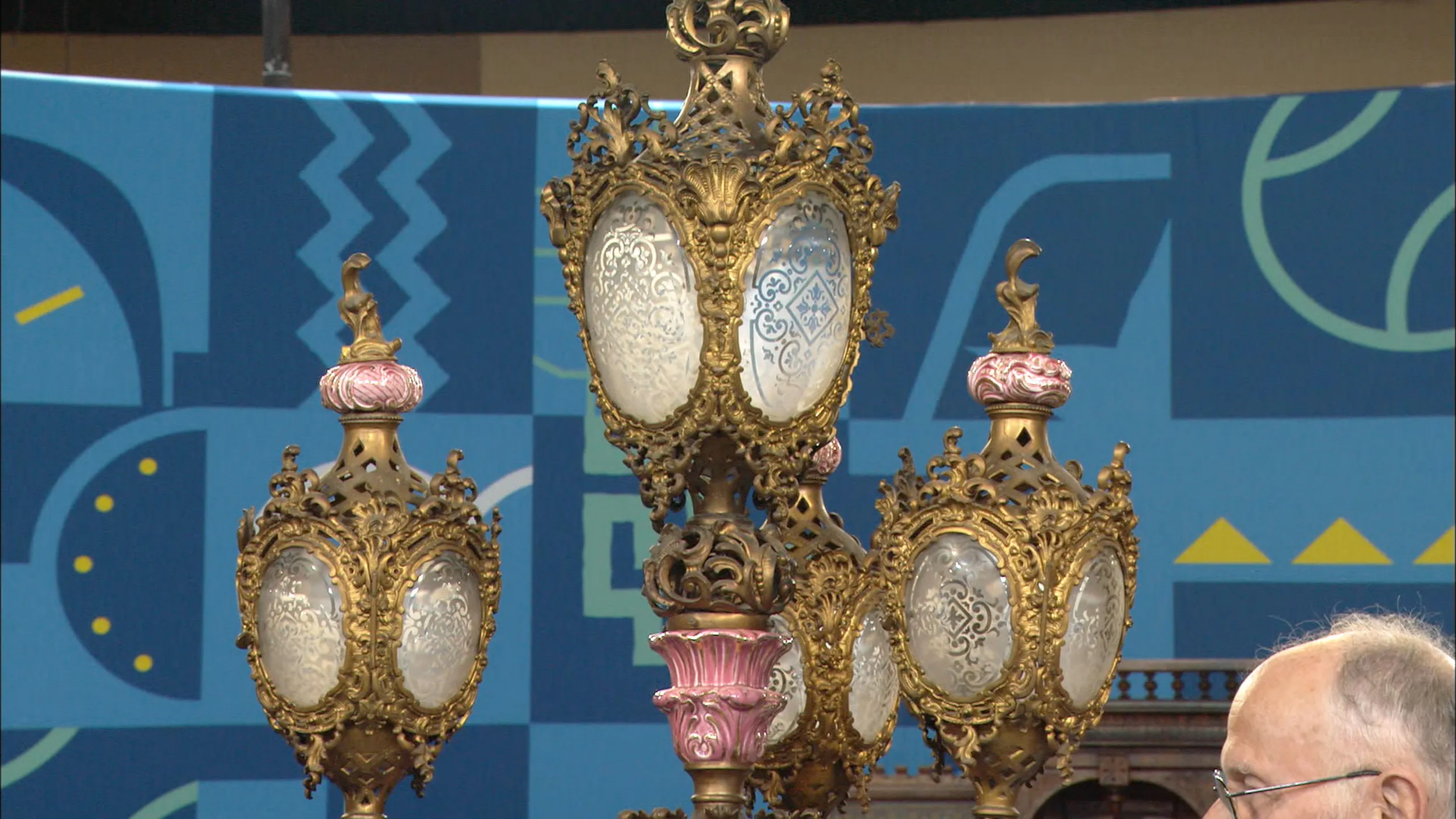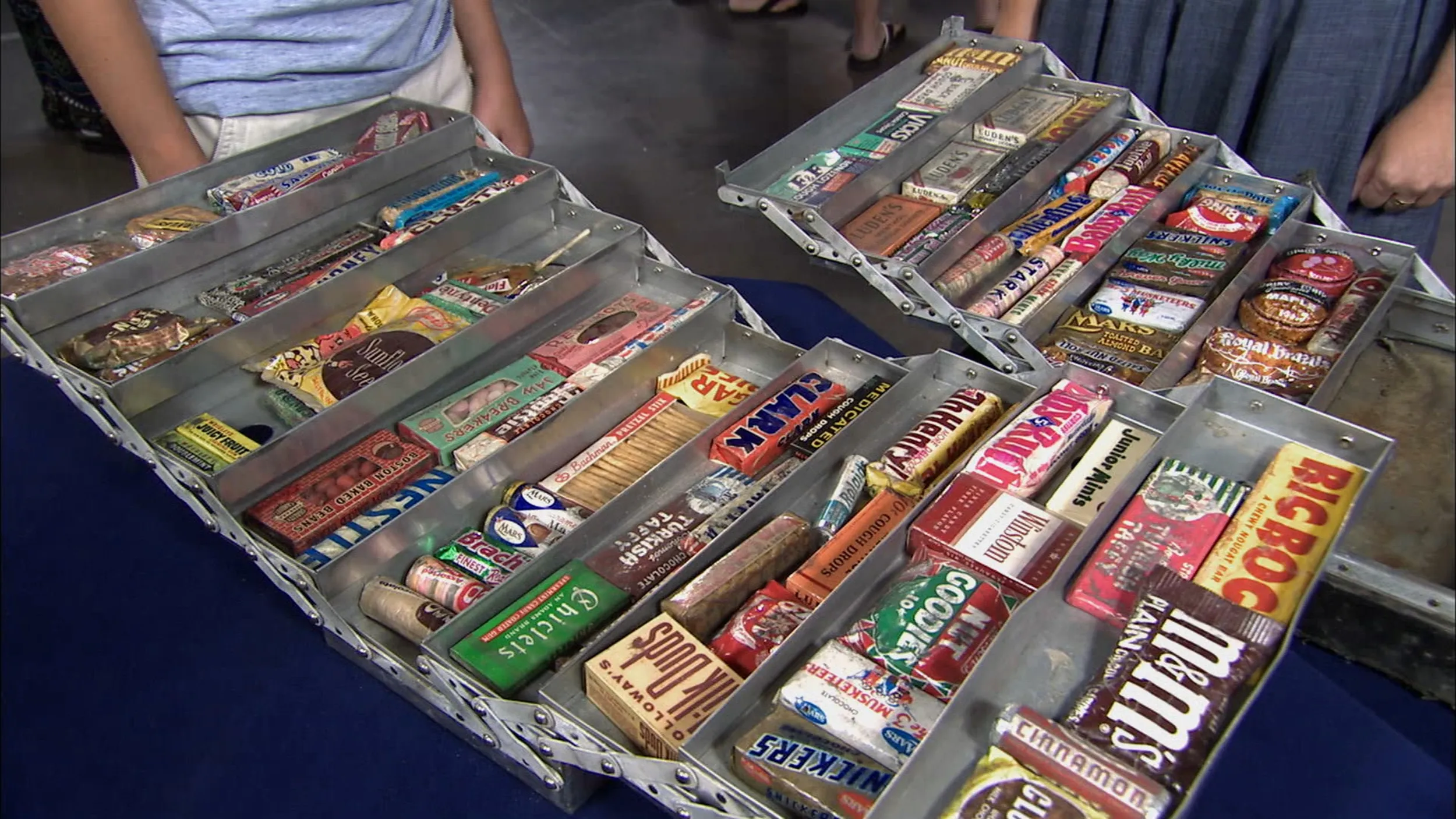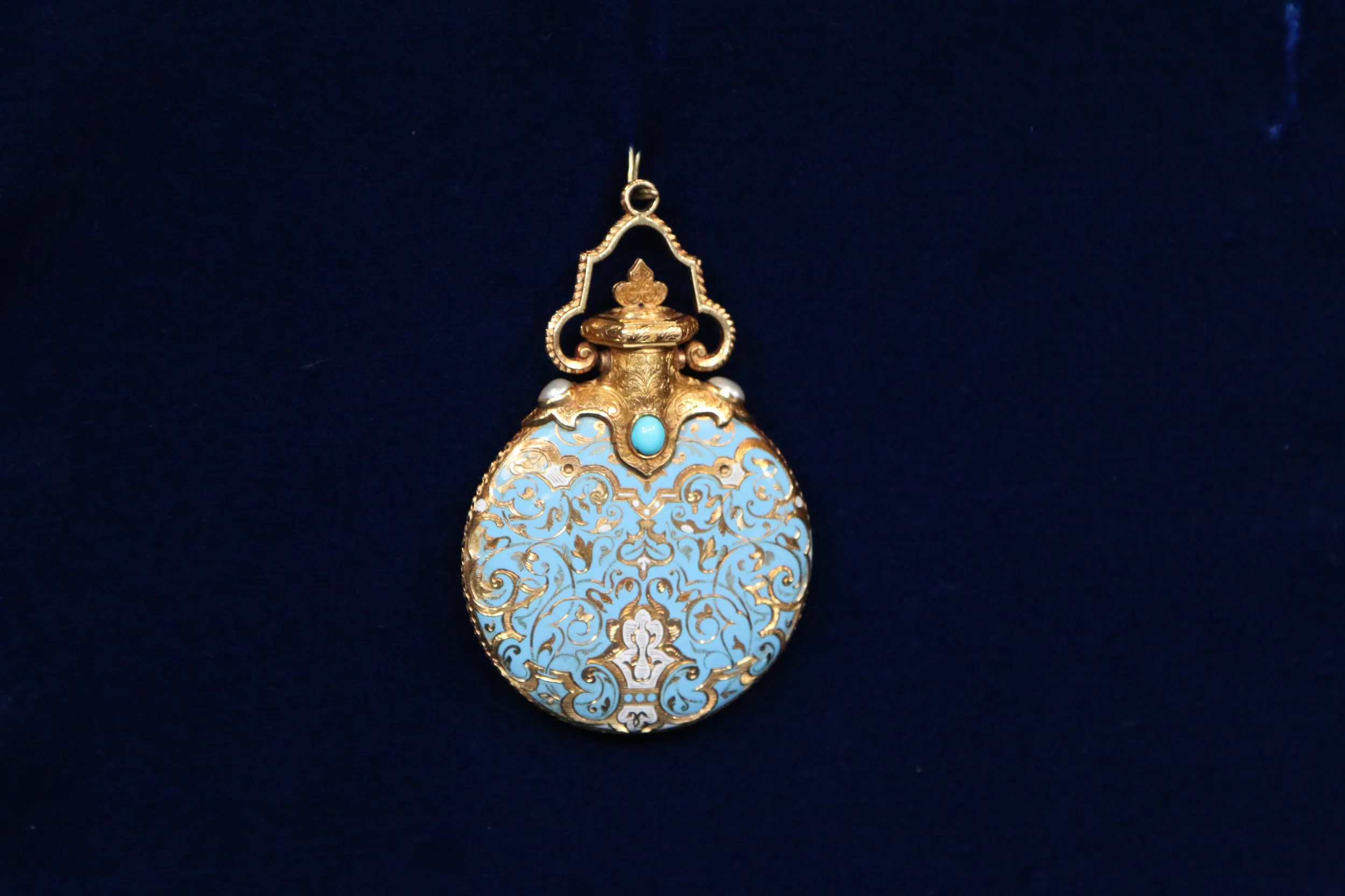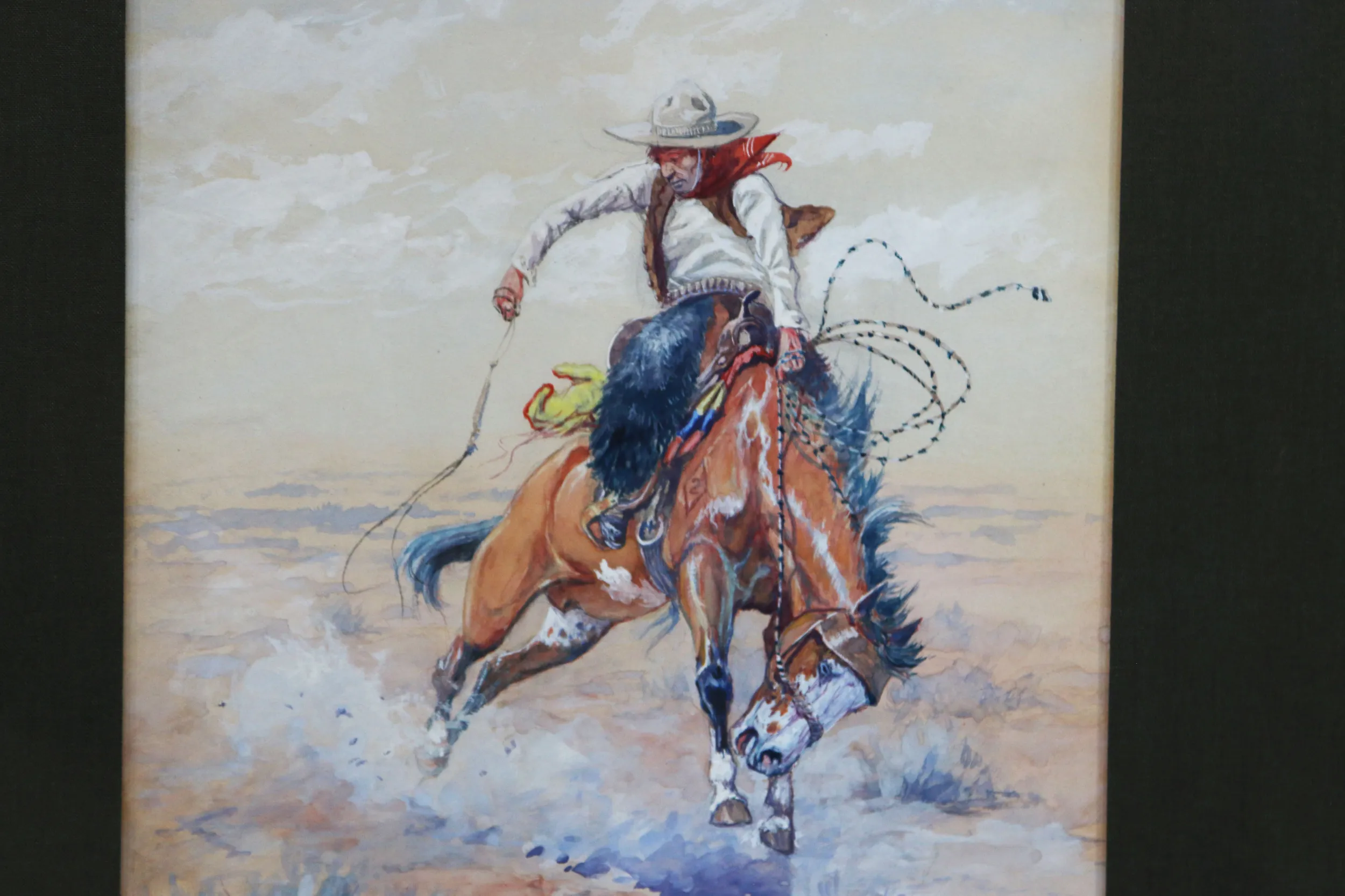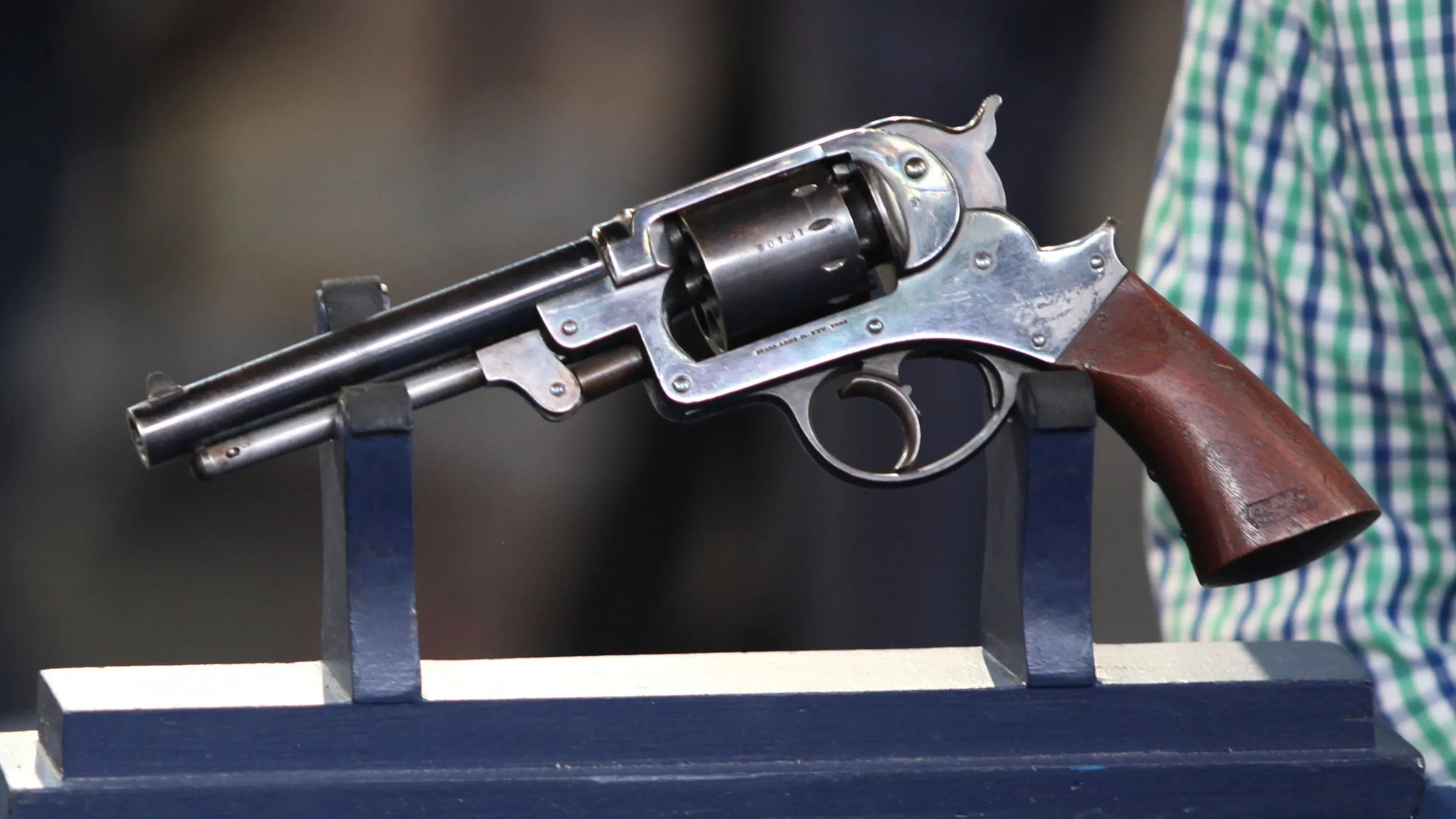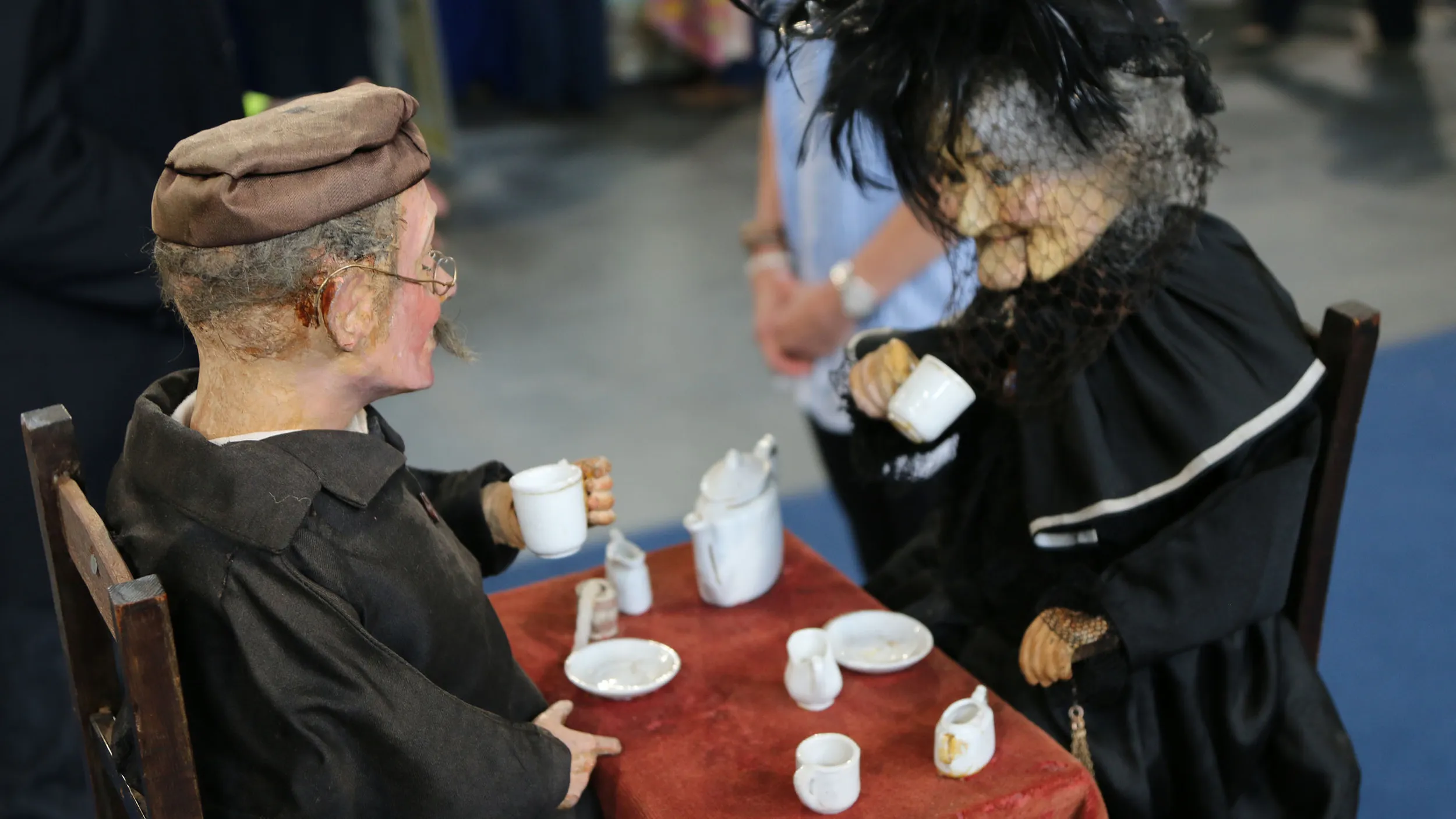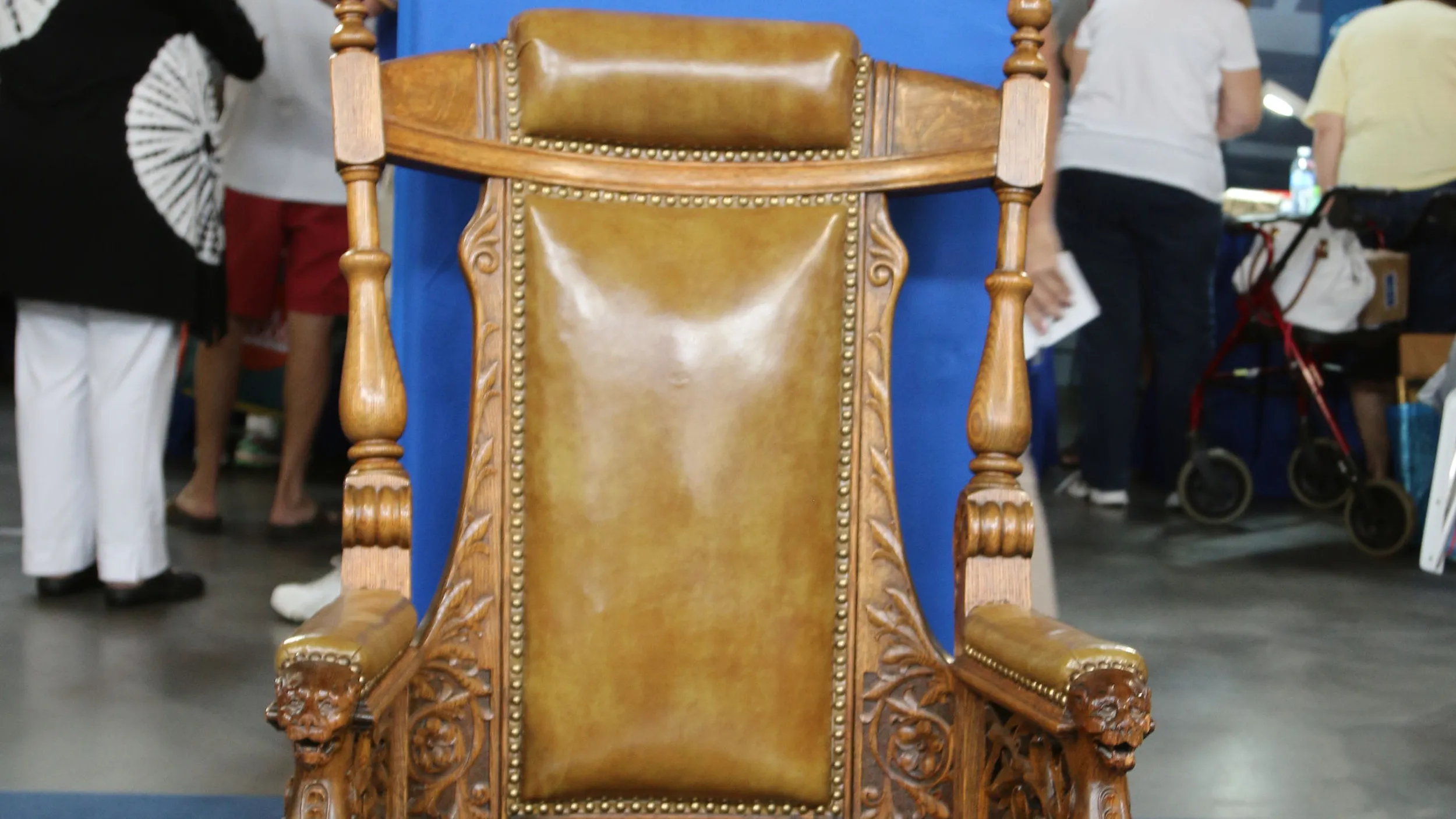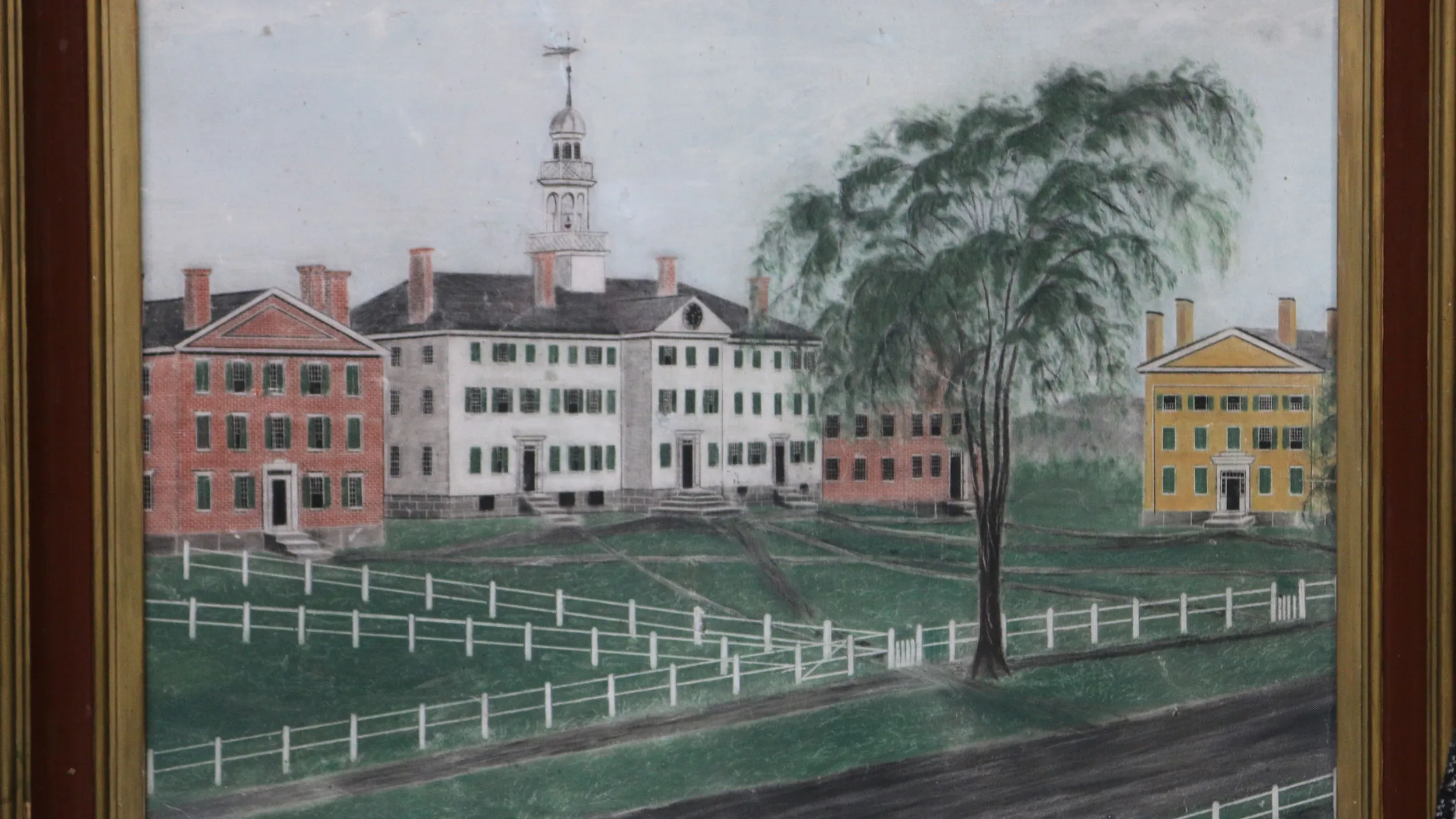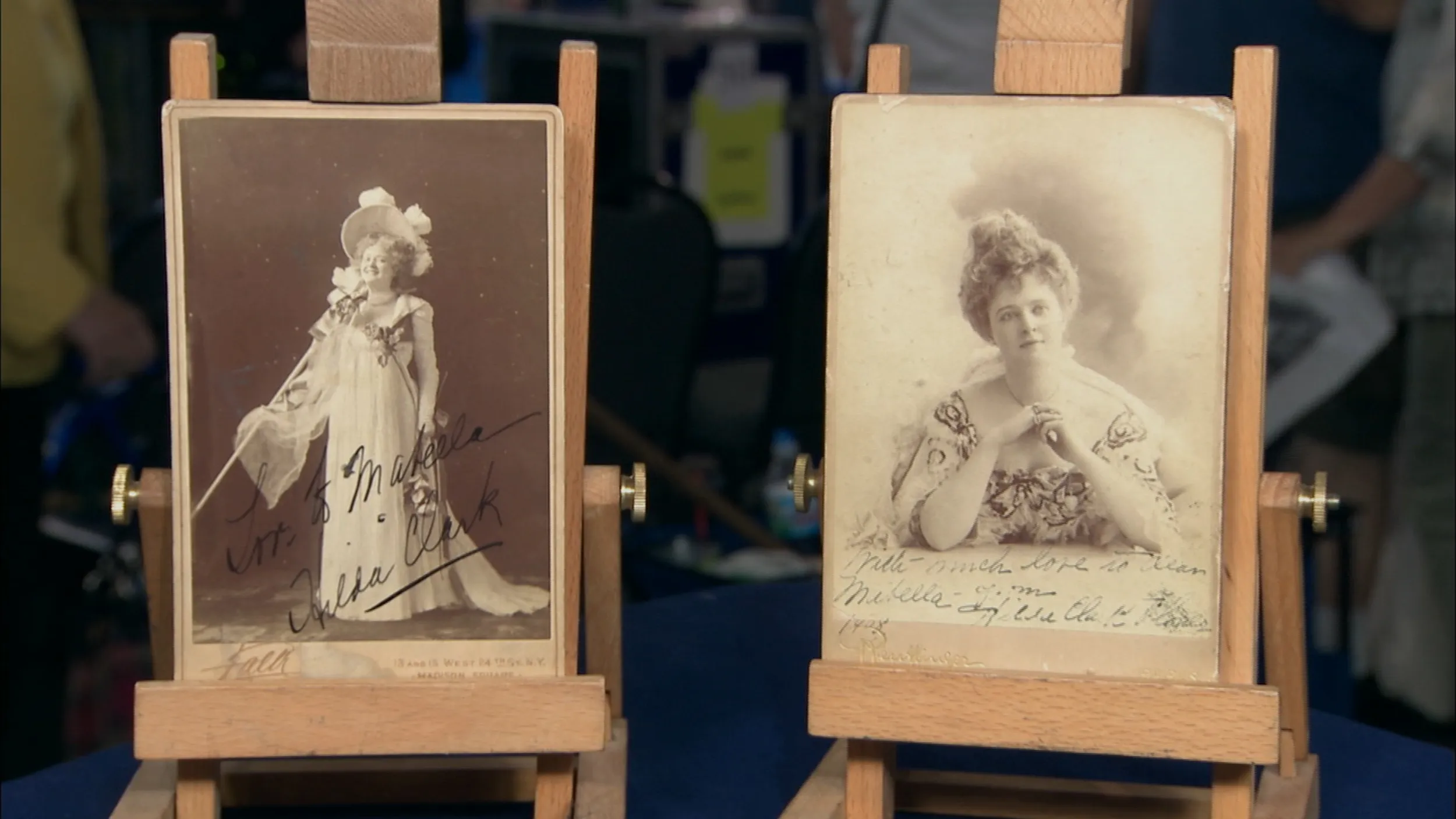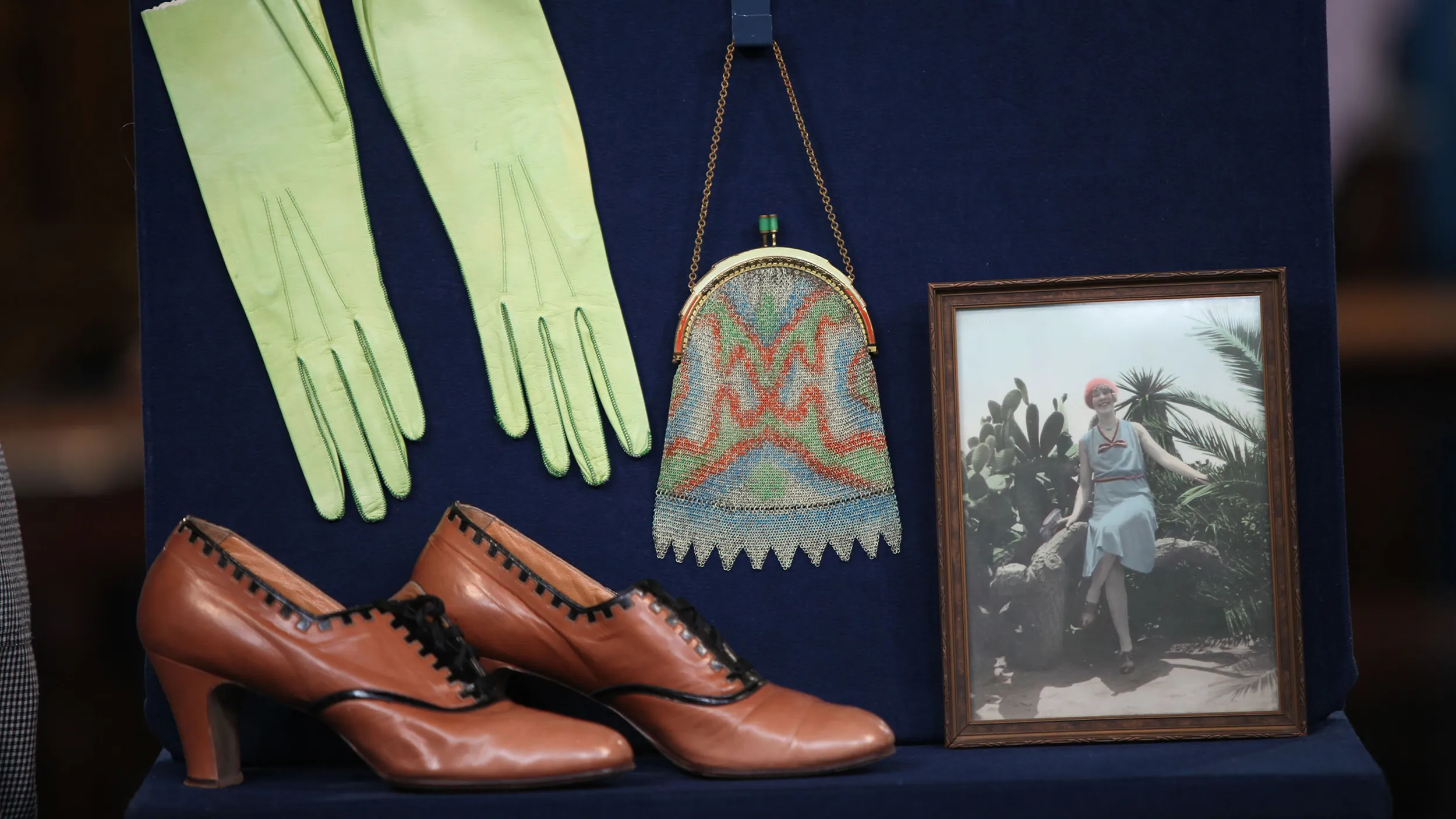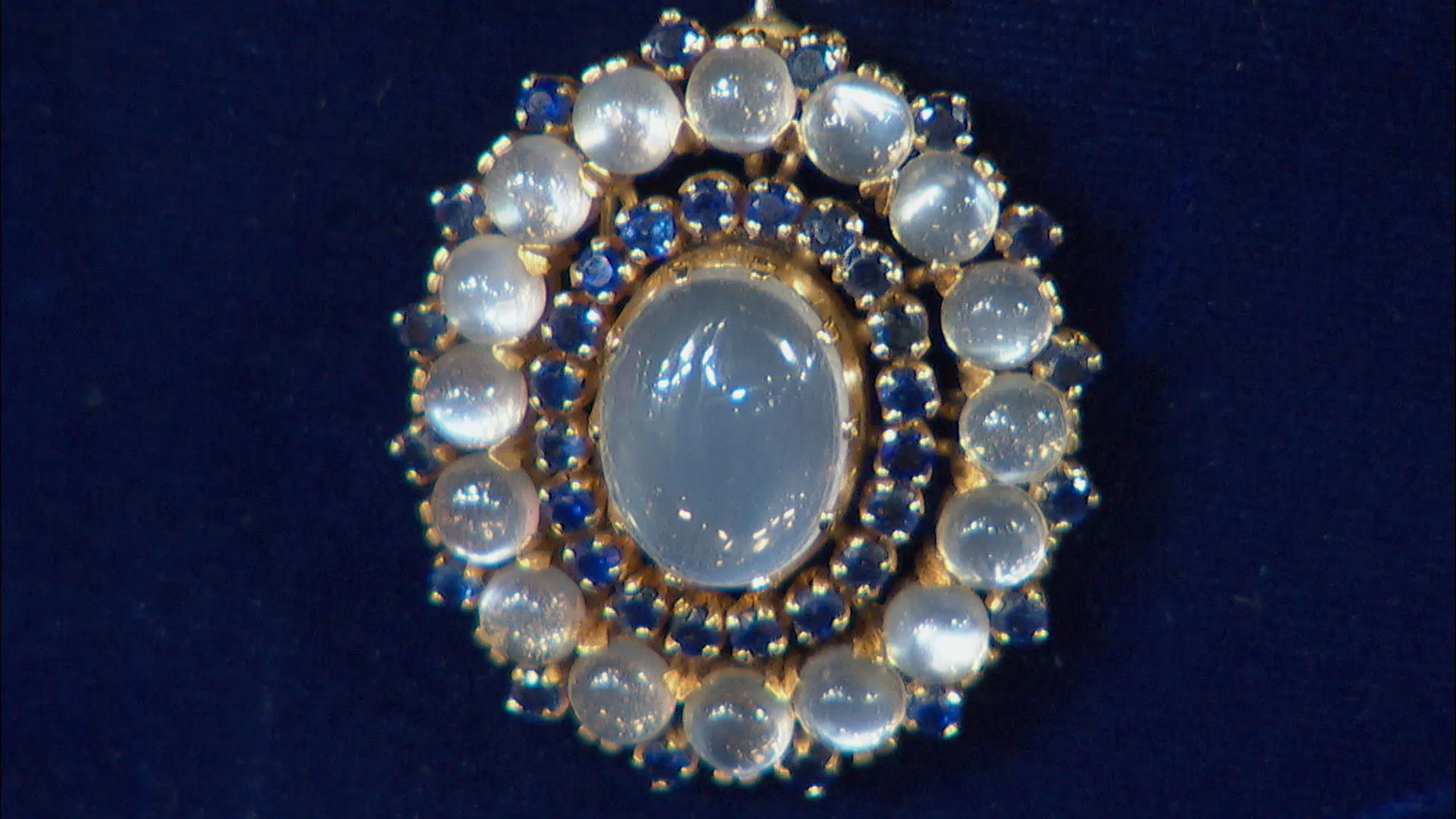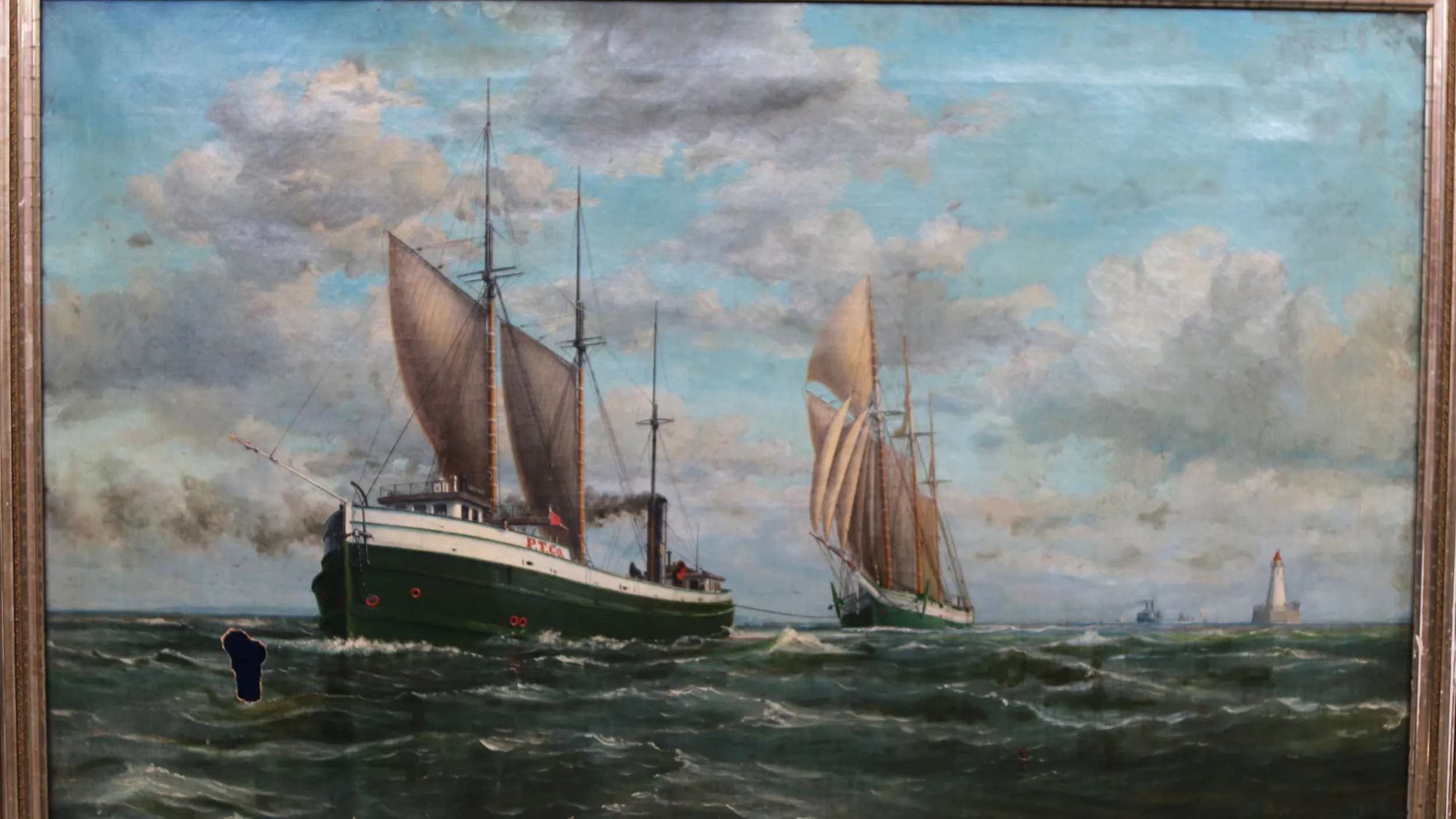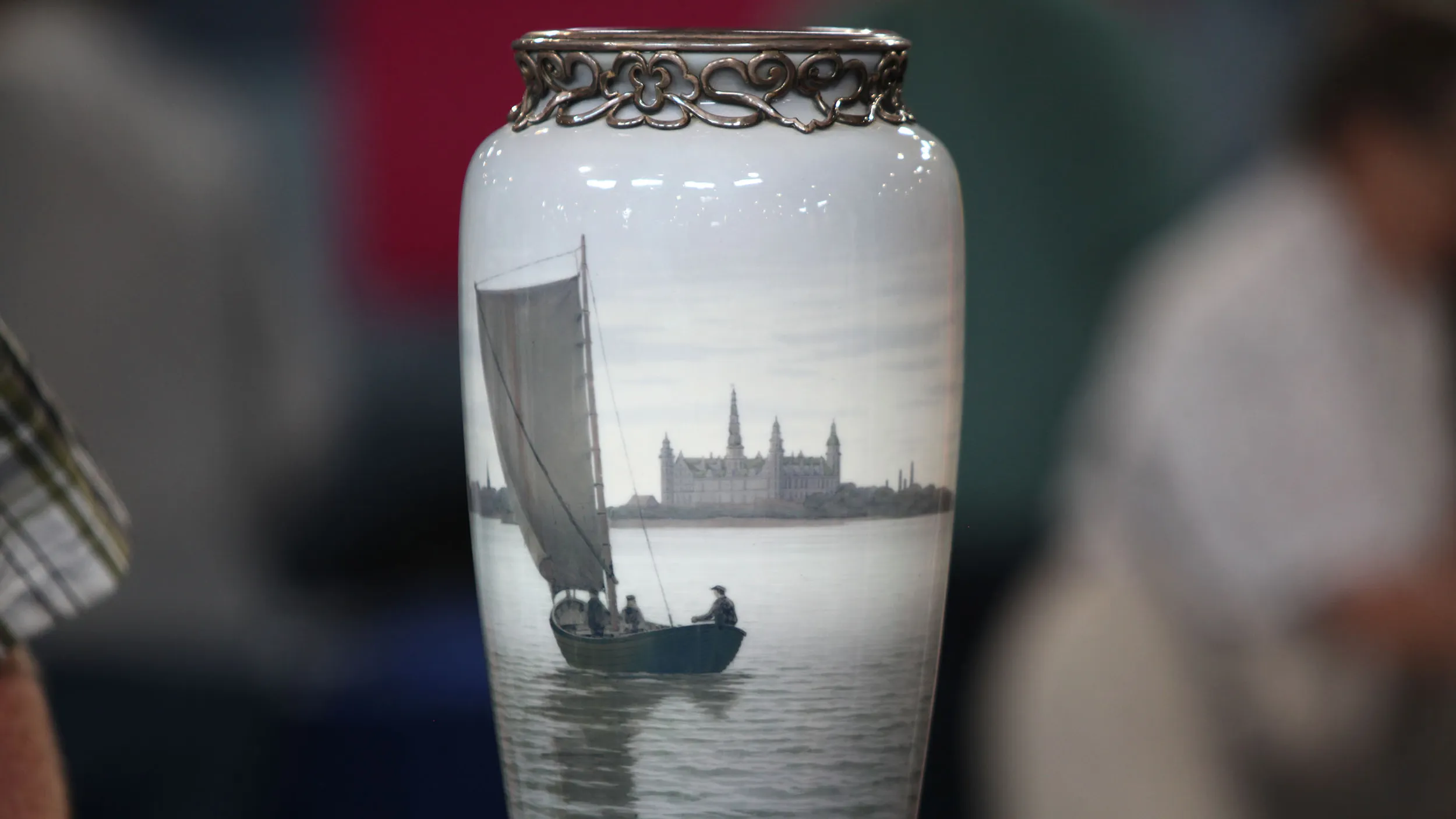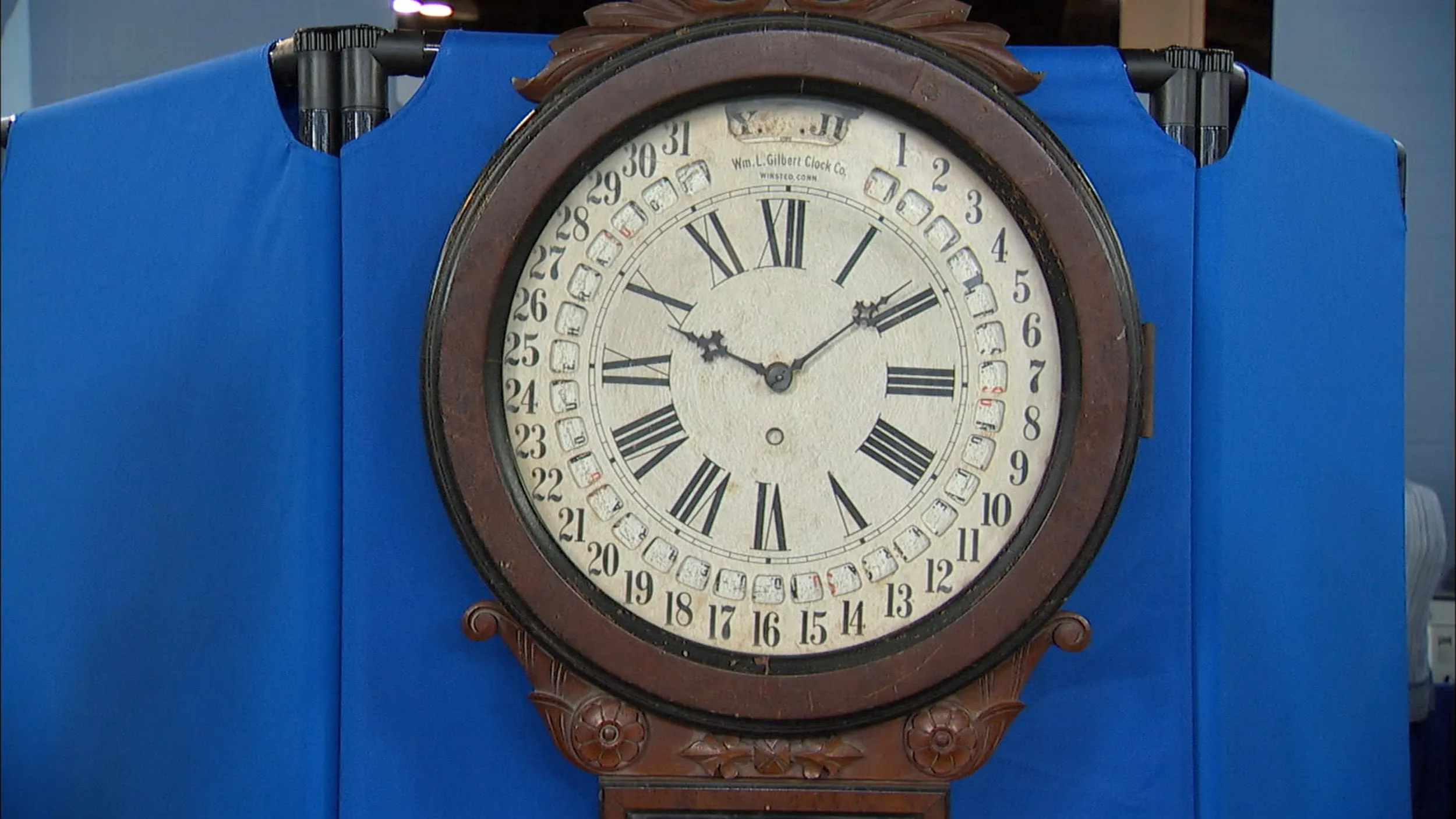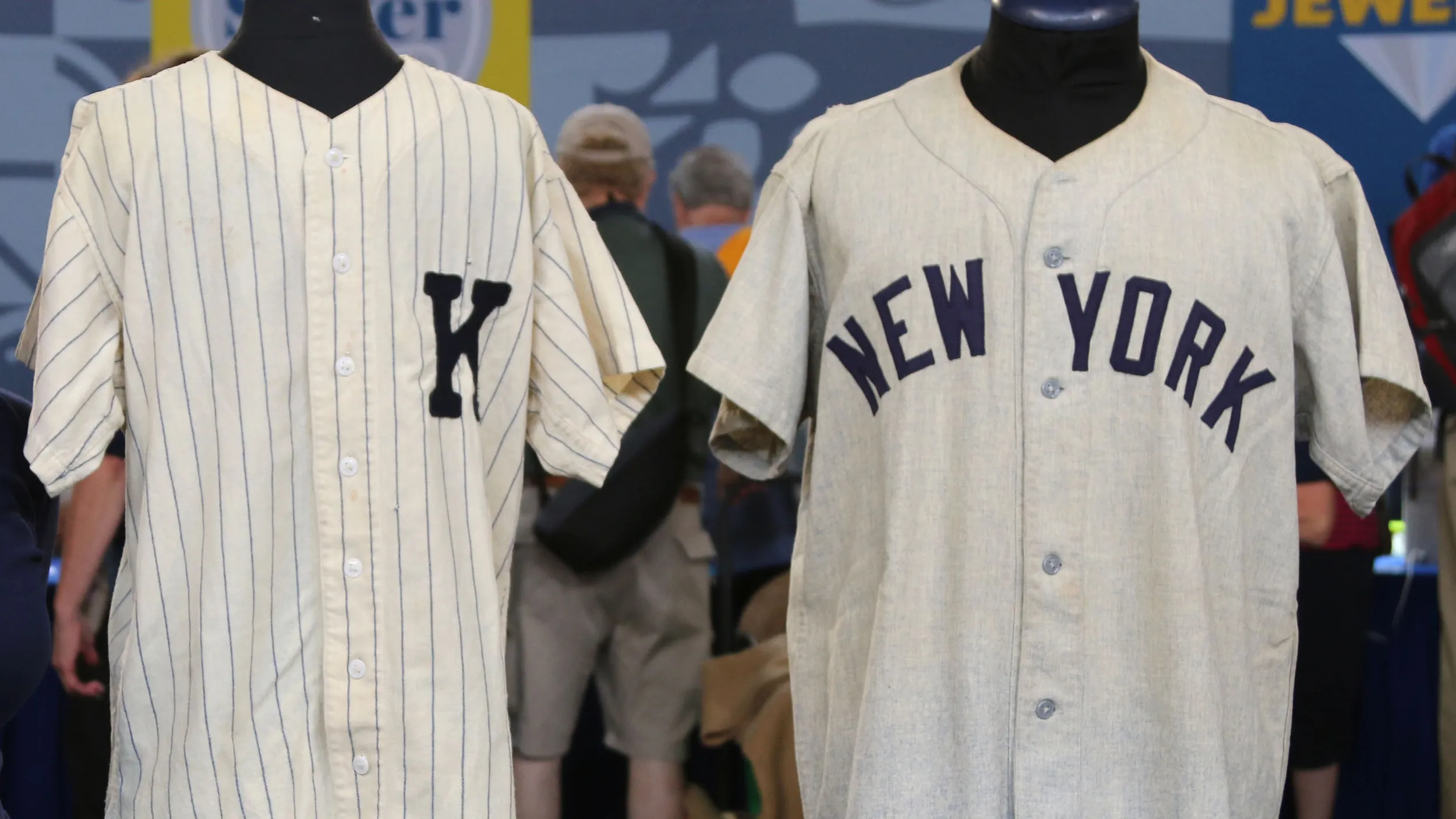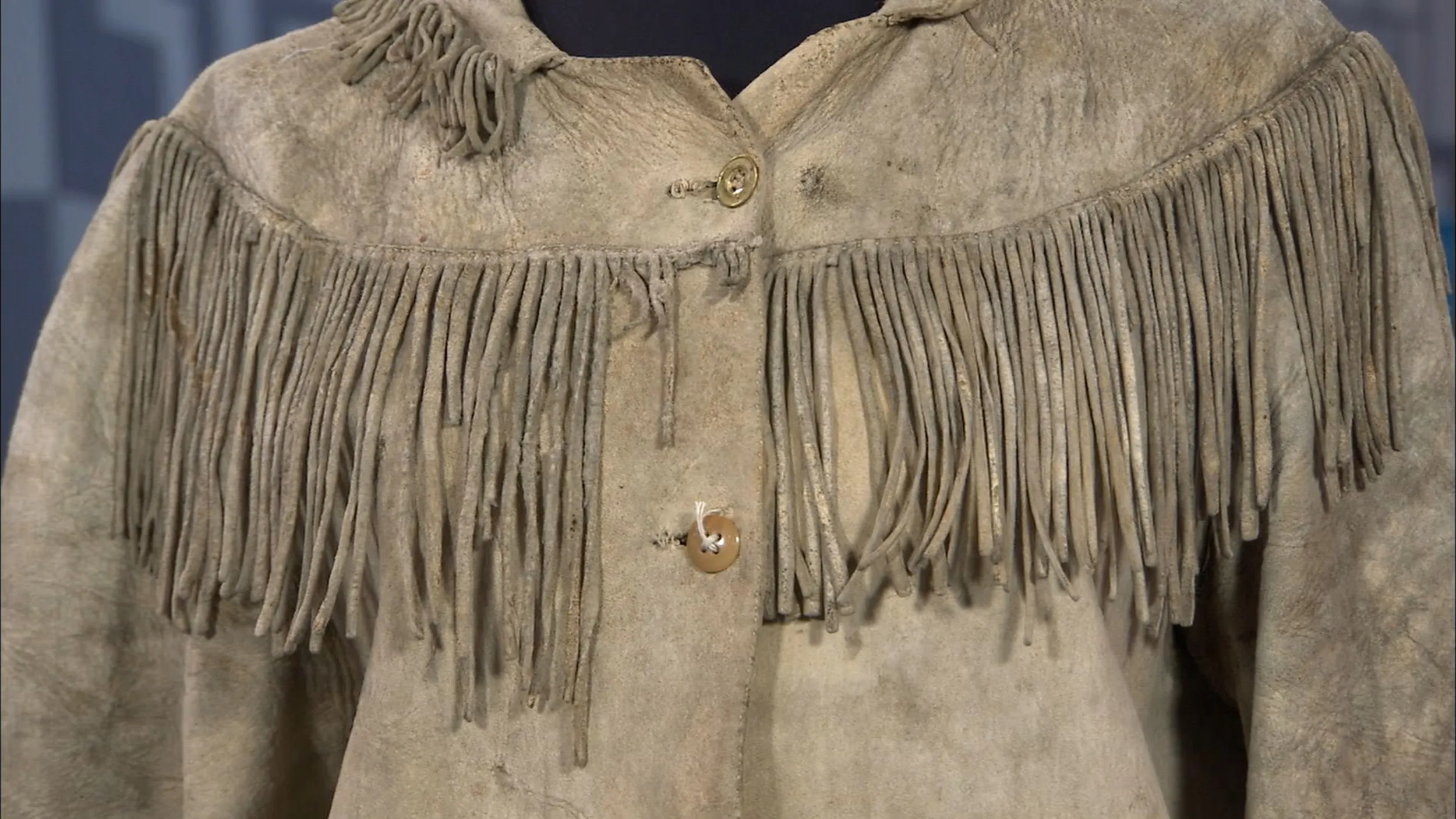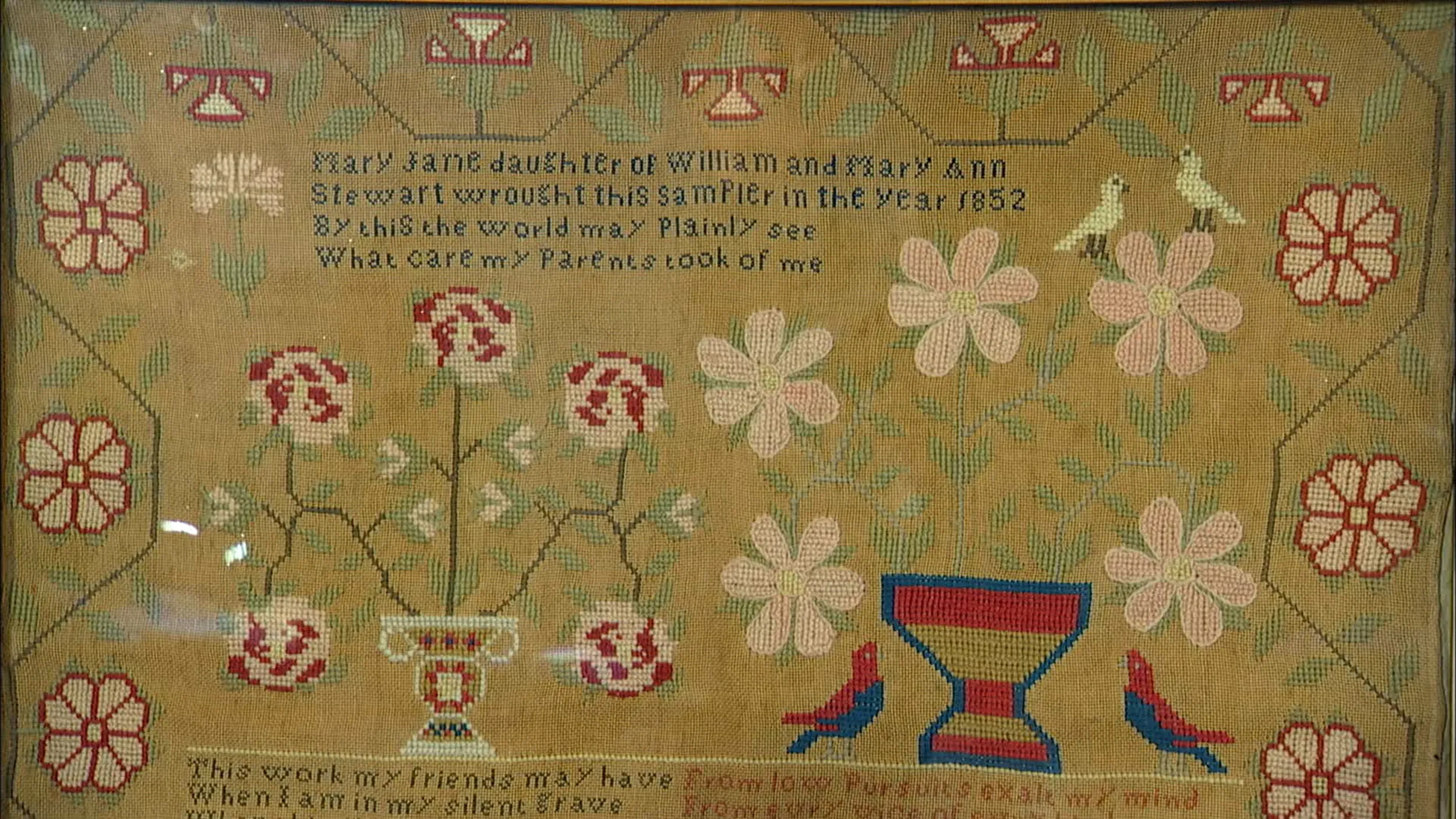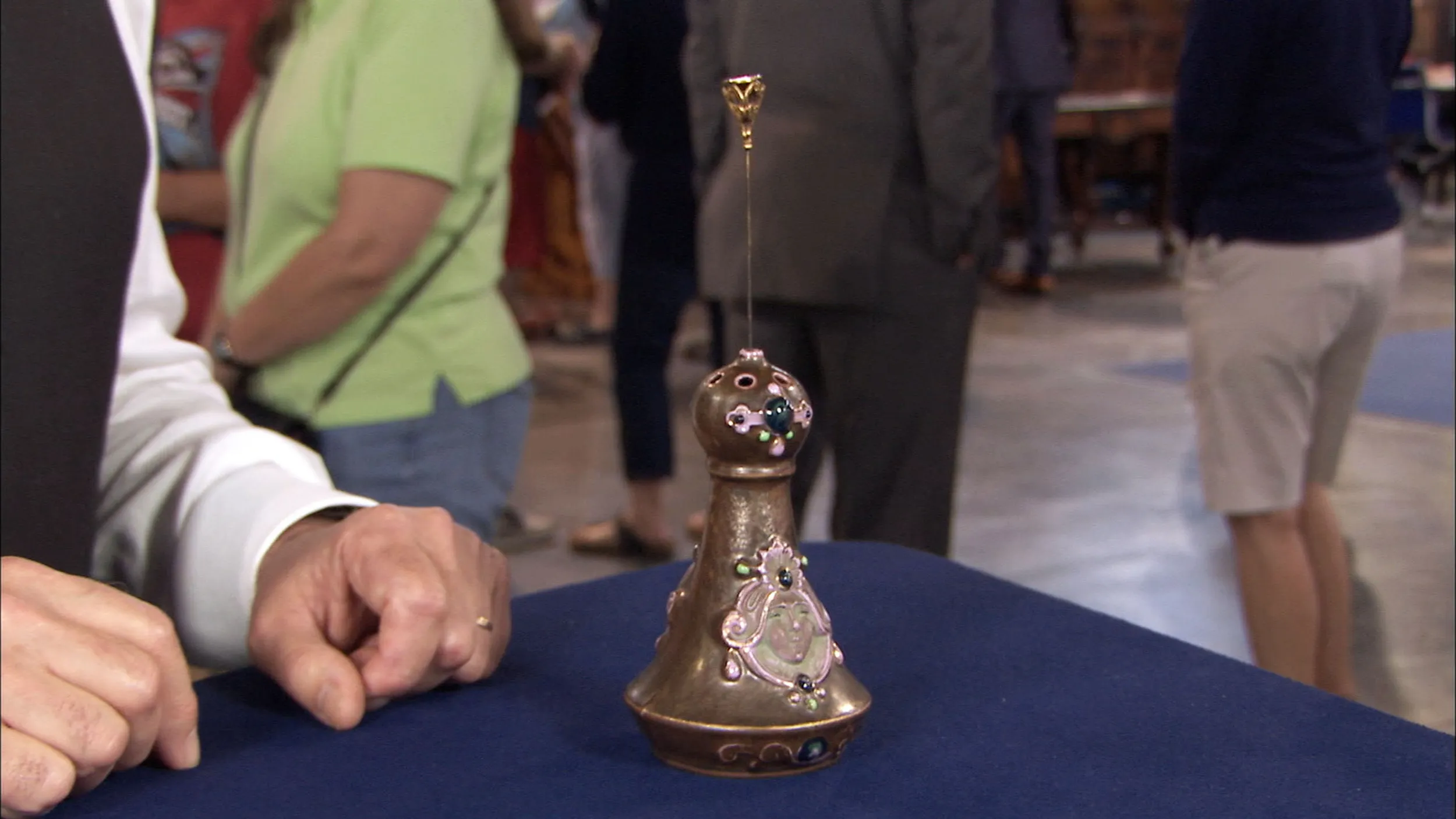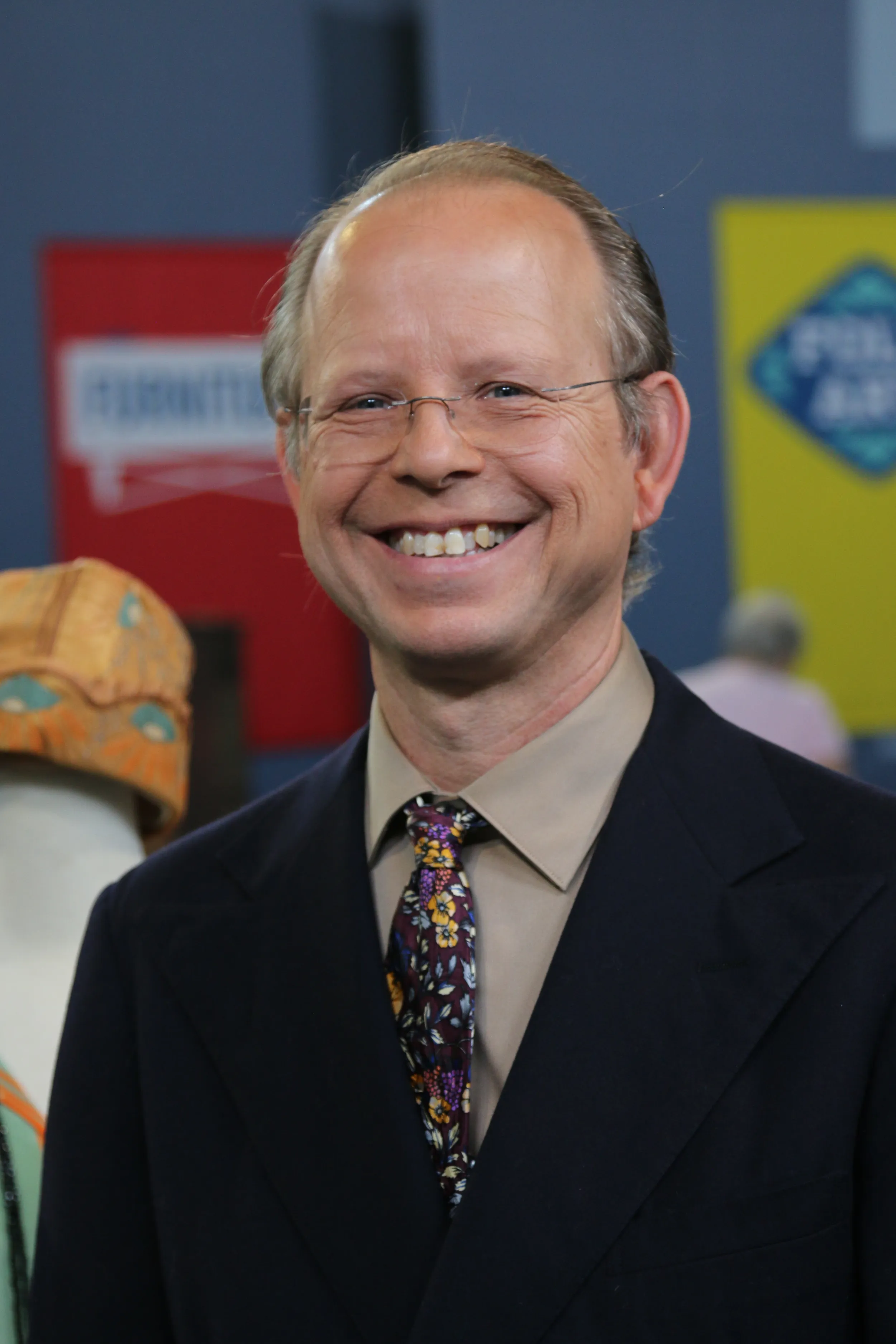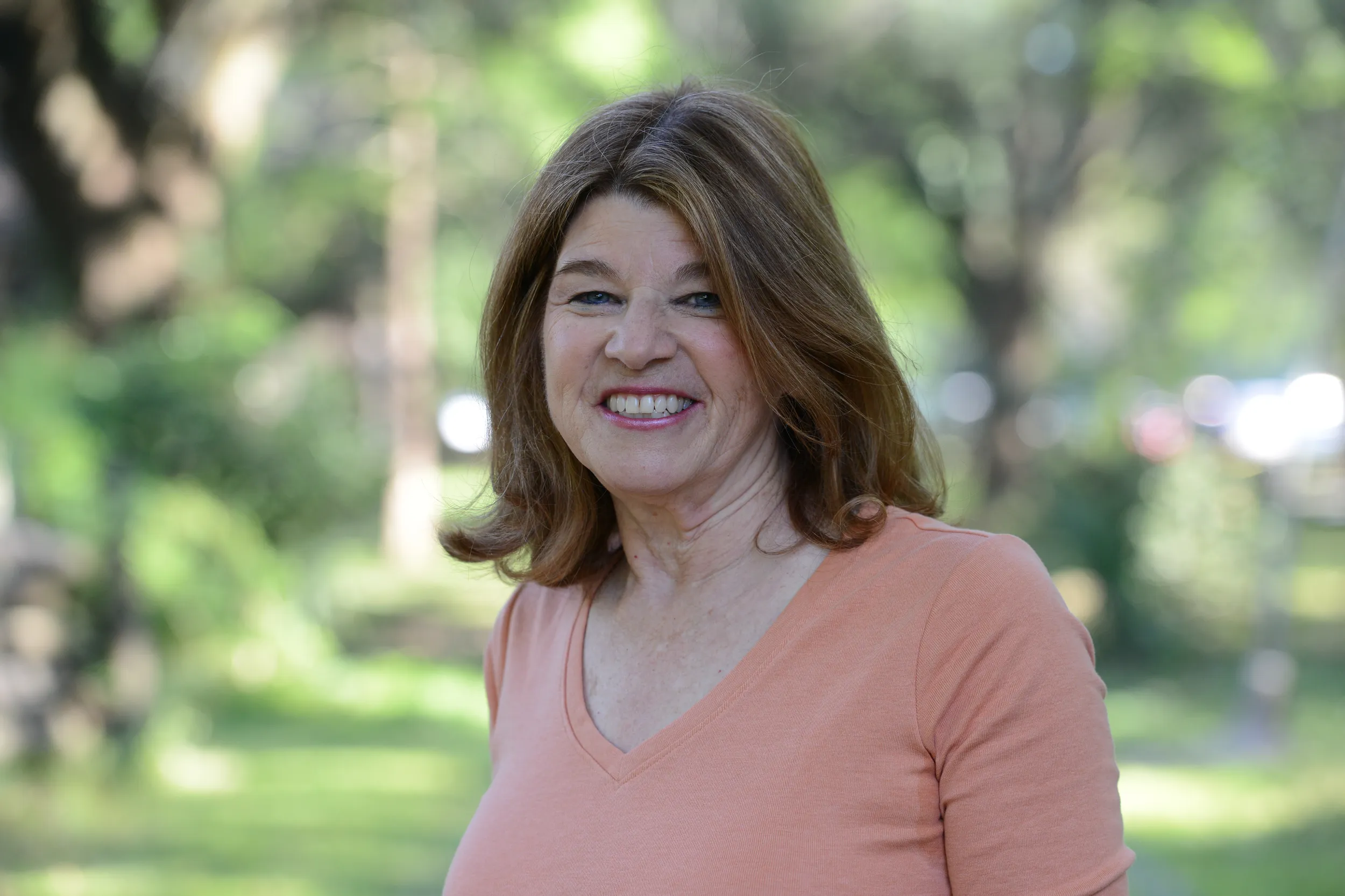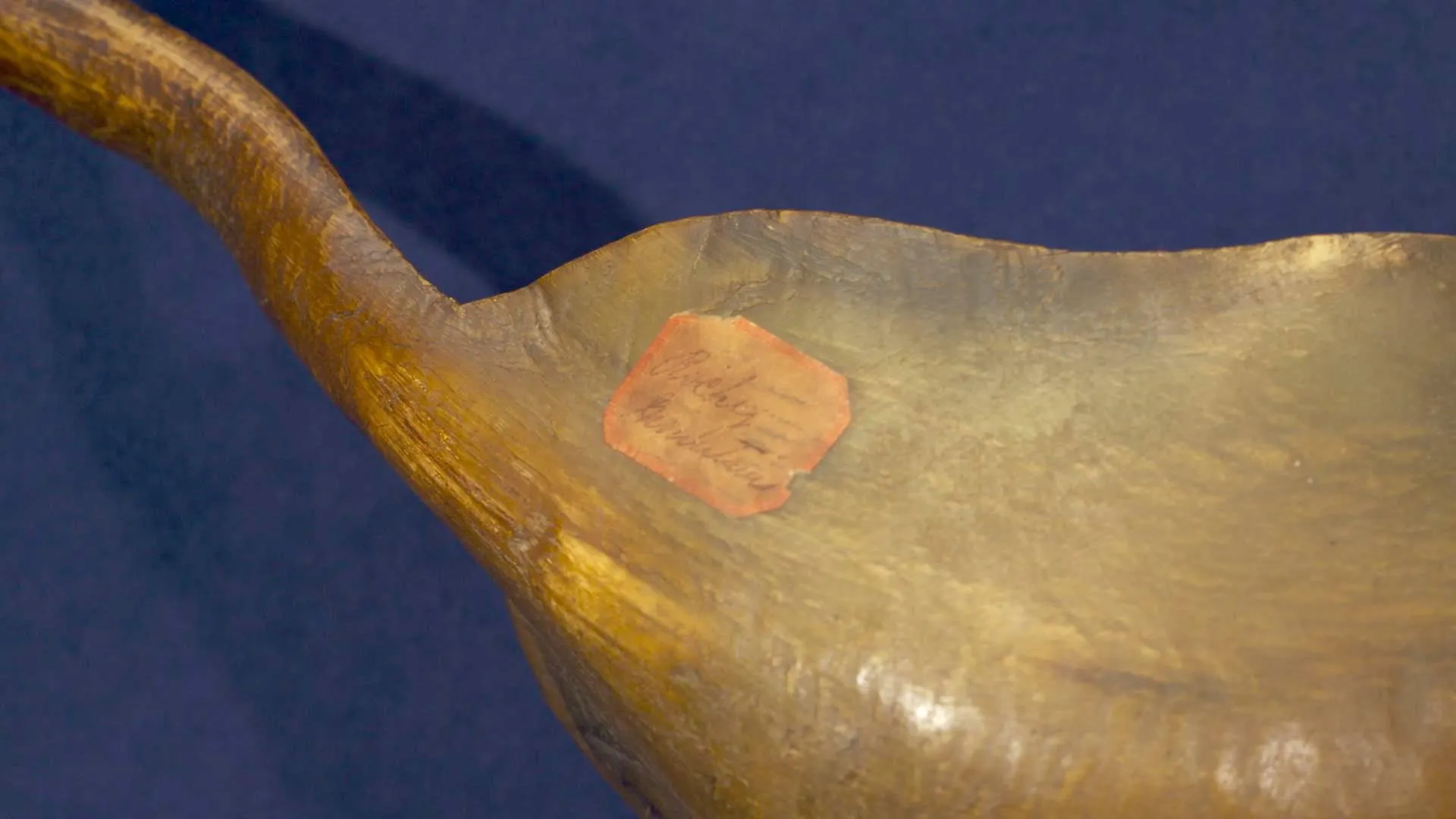HOST: Antiques Roadshow is seeing thousands of treasures in Omaha, Nebraska.
APPRAISER: Why didn't you like it?
GUEST: The faces just kind of creep me out.
APPRAISER: There's a pretty sizable hole. You want to wave to the viewers?
GUEST: There’s a little hole right here.
APPRAISER: There we go.
HOST: Antiques Roadshow found lots of great public art in Omaha. These bronze sculptures in Pioneer Courage Park are the work of Blair Buswell and Edward Fraughton and are said to capture the spirit of Nebraska's early white settlers, who began migrating to the area in the mid 1800s. Back at the Roadshow, we saw many Western treasures, including this letter from one Indian leader to another. Check it out.
GUEST: I was helping someone clean out a house. The bank had obtained this house through a foreclosure because it was in disrepair. They were throwing things in the dumpster, and because I don't like to throw things away unless I know what they are, I crawled in the dumpster and found a lot of things. Most of it I donated, but this I decided to keep because it was so unusual.
APPRAISER: How long ago was that?
GUEST: About eight years ago.
APPRAISER: It's a letter done in 1881. It is from one Indian chief to another Indian chief. But the subject material, tell me a little about that.
GUEST: Well, what I gathered was it was one Indian chief kind of telling the other Indian chief to basically behave himself because there was killings going on and he wanted it to stop.
APPRAISER: One of the issues with reading it is that he could write English, the chief, but as you read it, you realize that it was sort of a little bit circular. He starts off writing to this one chief, who was a Washoe, and obviously one of the big chiefs and very important, Captain Jim. They referred to the chiefs as captains because they were appointed captains or named captains by the United States.
GUEST: Mm-hmm.
APPRAISER: This Captain William, Chief William…
GUEST: Yeah.
APPRAISER: …is writing to Chief Jim.
GUEST: Mm-hmm.
APPRAISER: Saying essentially that Chief Joe wants to kill Annie, which is a woman, and he doesn't want him to.
GUEST: Right, yeah.
APPRAISER: And he's trying to broker peace. But at the same time, when you read through this, he's talking about that one of the Indians was drunk, one of them was misbehaving. And you get into this area here, he's saying one of the Washoe killed 12 members of another Indian's family.
GUEST: Yes.
APPRAISER: Well, it's fascinating to read through that. And then he's saying, "Well, you were supposed to make reclamation, you were supposed to pay."
GUEST: Right, you were supposed to pay.
APPRAISER: "You haven't done that, but I'm willing to overlook that." Then he's saying that she just wants to go to home to her family in Reno, because where the Washoe were was in California…
GUEST: Mm-hmm.
APPRAISER: …up near the border of Nevada and so on.
GUEST: Mm-hmm.
APPRAISER: And he's saying, "Look, this is what Captain Joe wants. "Could you talk to Captain Joe? I don't want to be aggressive; I want peace. I've let you fish in our streams, I haven't killed anybody." And then he says, "But," and this is the part that gets you. It's almost he's saying, "Well, if you do issue the order to kill her," in other words, put the hit out on her…
GUEST: Right.
APPRASIER: "I want you to pay me something.”
GUEST: Right! I know.
APPRAISER: “You've got to pay me some money." First of all, letters like this are incredibly rare. One Indian chief to another Indian chief is very rare. But actually talking about negotiations, killings, reparations, payments, they just don't show up. The Washoe are a tribe that is highly collected. If I were to conservatively estimate this letter, I would say $2,000 to $3,000…
GUEST: Hm.
APPRAISER: …Very, very conservatively.
GUEST: Wow.
APPRAISER: But it would not surprise me in the right setting that this might sell, retail, $5,000 to $10,000. Wouldn't shock me at all.
GUEST: I think it's called a torchère.
APPRAISER: Okay.
GUEST: Four lights, four lanterns. It burns gas. There's a pipe that runs up the center column to kind of a manifold here, and out these arms. These thread out to adjust a valve and up to the burner to make the light. We bought it in Albuquerque, New Mexico, at an antique shop, the kind of town center. The story we heard there was this was in an opera house in Vienna, Austria. There were six pink and six blue. All the others were destroyed. This made its way to South America, and then of course somewhere up to Albuquerque, New Mexico.
APPRAISER: Alright.
GUEST: But it's a story.
APPRAISER: Well, the Vienna Court Opera was commissioned in the mid-19th century by a group of people commissioning public works in Vienna. It begun construction in 1861. It finished construction in 1869. And the cornerstone of the building was actually laid in 1863. Now, there is a mark that we can't see that says the date "1863" on it, so the story that this could be from the Vienna Court Opera is plausible. It is a masterpiece of neo-Renaissance design, as was the opera house itself. We've got gilt decoration in this sort of majolica-type pink glaze that would have been relatively forward-thinking glaze for 1863, but we can believe that it is in fact 1863. It's earthenware pottery, probably made in Austria for lack of any more compelling evidence.
GUEST: Okay.
APPRAISER: Mounted all over in gilt bronze, the dolphins at the bottom all the way up through here to some foliage and all the way to the top to these incredible shades that are filled with frosted etched glass, all of which appear to be original. Torchère is a word that is generally applied to a multi-light item. We'd call this... we'd really call it a gaslight.
GUEST: Okay.
APPRAISER: And what did you pay for it?
GUEST: $2,400.
APPRAISER: Okay. Conservatively, at auction, because of the importance of this particular piece, the forward-thinking of its glaze, and the surprising originality of its condition, we would conservatively estimate this piece to bring $10,000 to $15,000 in today's auction market.
GUEST: Okay.
APPRAISER: If there are a few people that really get involved, it could well bring more than that…
GUEST: Okay.
APPRAISER: …But $10,000 to $15,000 is what we think it might do.
GUEST: Interesting.
APPRAISER: I wouldn't go all Gene Kelly on it.
GUEST: (laughs): No.
APPRAISER: It's definitely Art Deco. It's got this wonderful dancing figure. I would say $150 to $250 range, just because she's attractive and really pretty.
GUEST: Thank you so much.
APPRAISER: Wonderful late-19th century child's high chair. The value's gonna be way more sentimental than it is anything else. In this condition, it would maybe be $50 or $75.
GUEST: Okay, that's fine, well, thank you!
GUEST: My dad bought a candy shop up in the Black Hills, and then when he took possession of the shop, he was about to throw this out, and then he opened it up and saw what was inside.
APPRAISER: And then he gave it to you?
GUEST: Uh, yeah, I was searching in the garage for something to take to the Roadshow, and then I came across this.
APPRAISER: This is a salesman's case, so this was the full product line of everything that he had to offer.
APPRAISER: So the salesmen would take it around to the different candy shops and let people pick out what they wanted to carry in their stores, and so we see a really tremendous variety of stuff here. Some of the products I don't even think they make anymore. We think this is probably from the late 1950s based on the packaging, and at auction, we think it's really conservative that it would probably bring at least $500 to $700.
GUEST: Okay.
APPRAISER: And I think most of us wouldn't be surprised if the people who collect salesman's samples of vintage candy would go crazy for something like this, so if it went for more than that, I wouldn't be shocked at all.
GUEST: It belonged to my dad's aunt, who lived in Kansas City, and she gave the piece to my mother because she really liked her. I know she did collect antiques.
APPRAISER: And do you know how long it has been that she may have had this?
GUEST: She died in 1958, and I think she was in her 90s when she died, and she started collecting antiques in '32.
APPRAISER: Well, this is a very unusual piece, and it's one of the few pieces that are quite rare in my venue of dealing with antique and estate jewelry. The bottom portion here, this is a perfume flask, and you can see there's a little stopper up here. And this is done with a specific type of enamel work, which is called champlevé enamel. They engrave the design into the surface of the gold, they fill it with enamel, and then they sand it flush to the gold so they can create these beautiful Arabesques and designs. We've got turquoise and the Persian turquoise coloration of the enamels. And this would date somewhere around 1850, 1860, when there was a sort of interest in exoticism related to North Africa, Moorish designs, and to Middle Eastern designs especially. And so basically what we have here is a circular design. The flask moves up to the top with the hinge here. There's a pearl on the shoulder on either side.
GUEST: Mm-hmm.
APPRAISER: And this whole wonderful piece would have either been hanging from a chain or hanging from the top piece here, which is rather unusual because this is in the shape of a dragon. And the beauty of this is that the dragon part clips into the clothing, and one can see from the side view how the hook operates that one would attach the scent flask.
GUEST: Right, and that's how my mother wore it.
APPRAISER: And the purpose for scent flasks were when one walked down the street or was out and about in a carriage, horses were in the street, unfortunately garbage was in the street, and so if a lady was being overcome by either the heat or the scent, they would have these what sometimes were called vinaigrettes or scent flasks. She could open this up…
GUEST: Oh!
APPRAISER: …And have a lovely aroma to help revive her a little bit.
GUEST: Wow, okay.
APPRAISER: This is probably one of the most lovely ones I've ever seen. And then also, when we turn it around, we'll see that the design is the same on the back as well. I mean, this is really a wonderful piece of jewelry. It's definitely a one-off piece.
GUEST: So it really is one-of-a-kind.
APPRAISER: It is really one-of-a-kind.
GUEST: And is the gold... what karat gold is that?
APPRAISER: The gold is actually 18 karat.
GUEST: Okay.
APPRAISER: And it's all handmade. I would estimate at auction, a piece like this would be worth somewhere between $5,000 and $7,000.
GUEST: Okay.
APPRAISER: And it could go much higher than that depending on the audience or the collector's market for these type of items.
GUEST: Well, we've always loved it. My mother, like I said, wore it all the time.
APPRAISER: I've not seen another scent flask like this in years that has gotten me this excited.
GUEST: I have a painting that's been in the family for many years, and I don't know anything about it.
APPRAISER: Any idea where, how it came into your family, who collected it?
GUEST: I think probably my great-grandmother. She traveled, and she, I know, made the trip out to the West. And this would have been in the probably the first quarter of the 20th century.
APPRAISER: So this is a watercolor on paper by Olaf Carl Seltzer, and he was actually born in Denmark in 1877. When his father passed, he moved to the United States with his mother. That was about 1897. They settled in Montana. And he first decided he was going to be a cowboy, so he worked as a cowboy not too long, but a year or so, and then he ended up being a locomotive repairman. Sketched on the side because he liked to make art, but he was just doing it really as a hobby. Soon after he came to the United States, he met Charles Russell, who's one of the most important American Western artists of the 19th and 20th century. So he became very good friends with Russell, and Russell decided he was going to teach Olaf how to paint. By about 1901, so very soon after he met Russell, he was a pretty good and confident painter. Now, in the lower left of this painting, we have a signature, "O. Seltzer," and a date of 1905. He was rather young, about 28 probably, when he painted this picture. He did not become a full-time artist until he was about 44 years old, when he was laid off from the railroad. So this is very early, a very important time period, and really the part of his career that kind of sets the tone for what he would do the rest of his lifetime as an artist. An auction estimate today for this size work in watercolor by Seltzer would be $8,000 to $12,000.
GUEST: Wow. Very impressive.
GUEST: The husband of a cousin of mine had owned these, and they belonged to his grandfather. And how his grandfather obtained these, I'm not quite sure. I think he was the superintendent of one of the armories, and so when he left the armory, maybe he took a couple with him. I'm not exactly sure about them, so.
APPRAISER: Do you know who made these revolvers?
GUEST: The Starr Arms Company, but I don't know much about the Starr Arms Company.
APPRAISER: Well, the Starr Arms Company was located in New York, and we've got on one side of the frame, we'll have the Starr mark.
GUEST: Okay.
APPRAISER: And on the other, we'll have the Starr's patent. It was patented in 1856, but they didn't go into major production until the late 1850s.
GUEST: I see.
APPRAISER: And this is what they refer to as a double action revolver. But that's not quite true; they're actually a self-cocking revolver. So when you pull the trigger, it cocks back the hammer, but it doesn't fire it. That's what makes it a true double action, is if it fires…
GUEST: If it fires.
APPRAISER: …As you pull it back.
GUEST: I gotcha.
APPRAISER: What trips the trigger and fires it is actually a small secondary trigger.
GUEST: Alright.
APPRAISER: And that releases it. It was state-of-the-art for the time, but sometimes state-of-the-art isn't well received.
GUEST: I see.
APPRAISER: The soldiers didn't like it because it would break easily, and so they made a single-action after this where you cock it back, pull the trigger, and it fires.
GUEST: Oh, I gotcha, okay.
APPRAISER: One neat addition on this gun, did you ever notice the little slide?
GUEST: No, I didn't.
APPRAISER: That's one of the first functioning safeties on a pistol, and if you drop that down, it will allow you to cock the trigger, but it won't hit that concealed trigger. It's actually a functioning safety, which most of them didn't have at that time.
GUEST: Oh.
APPRAISER: The Starr Arms Company made about 23,000 of these guns in total.
Did you notice that all four marks, there's one on each side of the grip, they're different?
GUEST: No, I did not notice that.
APPRAISER: Because these guns were 10,000 serial numbers apart, they had different inspectors at different times.
GUEST: Alright.
APPRAISER: So you've got an earlier production and a late production. One special thing about these guns is the condition. When you see these, generally, they're worn out. They're just gray guns. They have no finish. Oftentimes, the mechanics are broken. With these, the action's fluid throughout, they have lots of the original bluing case color. If you notice, it's even a bright blue. When you have it, it's just really pretty. So it's substantially better than most of the ones you encounter. One neat thing about these guns is that they were made under government contract for the Union Army. These guns, because of the condition, would retail for about $3,000 apiece.
GUEST: Oh, really? Wow. I'm amazed at that. Very surprised.
APPRAISER: Without this finish and this condition, they're a gun that usually sells in the $1,000 to $1,200 range, so these are substantially better than the standard ones.
GUEST: Well, very good. That's very nice to know. Thank you for your information.
APPRAISER: You're very welcome.
GUEST: This was Roy Rogers' walking stick. I obtained it directly from Roy's son, Dusty, Roy Rogers Jr.
APPRAISER: They are made more than likely for the tourist trade. A G.I. or somebody was walking down the bazaar, they would be something that would catch their eye.
As a group, it would be somewhere between $1,500 and $2,500.
APPRAISER: You threw a heavy sock at me.
GUEST: I did throw a sock at you.
APPRAISER: And what do we have that came out?
GUEST: It's a whale's tooth. It was a piece of our family history, my husband's family history. Either his great-grandfather or great-great-grandfather did a favor for the original artist. He was a whaler, and he gave that to him in appreciation for it.
APPRAISER: We see a lot of whale's teeth or supposed whale's teeth at the folk art table, and the minute this thing popped out of the sock, I knew that it was right, it's a real whale's tooth. This is probably from the mid 19th century, 1840s, 1850s. It's got a whaling scene on one side…
GUEST: Right.
APPRAISER: …With the boats, and then on the other side, it gets a little juicier. We have a battle scene with an American ship and a British ship, and one sinking. So have you ever had this appraised, or…?
GUEST: No, we took it to a person, told us $500, he'd buy it from me, and I refused.
APPRAISER: In a good auction, that would probably bring $6,000 to $8,000.
GUEST: Wow! Dang, thank you!
GUEST: I got this from my friend Jim, and he was the funniest man I've ever known, and he collected all sorts of things. And he knew that I never liked this--I always thought it was really creepy-- so when he passed away, he left it to me as a joke.
APPRAISER: Why didn't you like it?
GUEST: I just, I don't know, the faces… just kind of creep me out. I know it's probably a very important piece, and it reminds me of Jim.
APPRAISER: How long have you had it?
GUEST: Only a couple years.
APPRAISER: Have you done any research on it at all?
GUEST: No. I- I-- just by looking at it, I think it's Victorian, but that's all I...
APPRAISER: Very Victorian.
GUEST: Okay.
APPRAISER: This is a German automaton. Sometimes they're referred to as mechanicals…
GUEST: Okay.
APPRAISER: …Made in between, I would say, 1898 and 1910. You can see what the subject matter is. It plays music and it also moves--that's the definition of a mechanical. If you look, it's an older woman here, and normally, her mouth moves. If you turn it around... you can see the key wind mechanism here and the key that turns it on and off. Unfortunately, it's not working. Did it ever work when you first got it?
GUEST: It did. In fact, that was one of the things that I kind of thought was creepy, when it moved, um, but it did work even as recently…
APPRAISER: Okay.
GUEST: …as this past week.
APPRAISER: Normally if it was working, the eyes on the dolls would move.
GUEST: Yeah.
APPRAISER: And also they would be drinking tea. It is sort of creepy if you look at it. Sometimes, these had labels on them. Unfortunately, this one doesn't have a label. There were various German firms that made these mechanicals. The heads are made of papier-mâché.
GUEST: Okay.
APPRAISER: The clothes are all period. The box looks like the original covering for the box. I think these items have been added at some point in time. It's not the most attractive mechanical I've seen.
GUEST: Yes!
APPRAISER: But it's a nice version of it…
GUEST: Yeah.
APPRAISER: And the subject matter is good. On today's market at auction, this would bring in between $1,500…
GUEST: Okay.
APPRAISER: …And $2,500.
GUEST: Okay, all right, thank you. Well, Jim would be happy to know that.
APPRAISER: That's good.
GUEST: Well, my grandfather was in public office, and they were remodeling, and when they did so, they were gonna get rid of all the old furniture, so my grandfather asked, and this is him in the picture.
APPRAISER: That's your grandfather seated there?
GUEST: That's my grandfather right there.
APPRAISER: So he was an elected…
GUEST: He was. He--
APPRAISER: …City council member or something like that?
GUEST: At this time, I think he was city commissioner. He was also police commissioner. He was acting mayor part of the time, whatever.
APPRAISER: Really?
GUEST: But here's the picture. This guy's sitting in the chair, so he had it redone and he took it with him when he left public office.
APPRAISER: With permission, of course, right?
GUEST: With permission, with permission, yes.
APPRAISER: So this was the equivalent of his gold watch after public service.
GUEST: Yes, it was, exactly.
APPRAISER: I think it's totally cool, particularly because it's got a lot of local interest. It's the Omaha city mayor's chair.
GUEST: Right.
APPRAISER: Which we know, it's not just conjecture, it's an iron clad story because it's documented here in the photograph.
GUEST: And I have more photographs of it as well, but this one was actually published in a July issue of Life magazine.
APPRAISER: Right, and actually we figured it out, it says "Compliments" right here.
GUEST: Oh, okay.
APPRAISER: It says, "Compliments, Life magazine, July 1947."
GUEST: Yeah.
APPRAISER: It's such a cool thing because in the world of public furnishings and redecorating, a lot of things get discarded and lost to time. And in the world of office chairs, this is, like, the greatest thing…
GUEST: Wow.
APPRAISER: …That's ever shown up. I mean, it is so elaborate. This is really a happening chair. We would describe it in art historical terms as being a Renaissance Revival, a carved oak Renaissance Revival office chair. You've got these lion's head griffins that create the arm supports. Some of the other things that one sees in the Renaissance are carved elements that show up here in the sides in the arm supports. This big scroll that's accentuated with the quatrefoil or that big floral element in the middle, and the scrolls here at the back of the stiles. So it really has a lot going on. The carving continues onto the back, which is terrific. This really shows a full expression of the Renaissance Revival. It dates to probably about 1880, and I suspect it was made between Chicago and Pittsburgh or Buffalo. That Great Lakes region was a big manufacturing hub of furniture, which was then put onto trains and dispersed around the country. From a condition standpoint, the chair itself is in remarkable shape. It has been reupholstered, and in the world of what you can and cannot do, changing the upholstery is like changing the tires on your car.
GUEST: Oh, so that wasn't a bad thing.
APPRAISER: It's not a big deal. I would say this chair, in today's auction estimates, we're looking at something that's $3,000 to $5,000.
GUEST: Wow. Well, to us, it's just a great family... thank you.
APPRAISER: Great family heirloom.
GUEST: Yes. It's such a wonderful object.
GUEST: Thank you.
GUEST: It's a folk art painting I acquired many years ago, and I know nothing about it. It was at an estate sale, and I walked in, and this was on the wall next to the stairs, and I thought, "Yes, I have to have that."
APPRAISER: Now, how long ago was this estate sale?
GUEST: About at least… ten to 15 years.
APPRAISER: Okay, do you remember how much you paid for this?
GUEST: $25.
APPRAISER: Well, this is a wonderful early 19th century rendering of an early campus. It looks New England to me just by virtue of the buildings. It's pastel, charcoal, and sand on paper.
GUEST: Oh!
APPRAISER: And so you get a little bit of the shiny glitter will show through of the sand.
GUEST: Mm-hmm.
APPRAISER: And usually, these works are in charcoal, they're black and white, and this is worked in beautiful, brilliant color. The buildings are a little... they're quite well done, but they're probably a little bit out of perspective. The condition is fabulous, it's a very large piece, and many times, we don't have… we don’t have a photograph of these structures as they appeared at this time, maybe 1820, 1830…
GUEST: Oh, my.
APPRAISER: Something like that. If this were to come to auction, if we don't know where this place is, if it's an unidentified academic setting, academic landscape, I would say an auction estimate would be $3,000 to $5,000. If we identified this location, and I do believe we could with a little bit of time, you've got an $8,000 to $12,000—
GUEST: Oh, my!
APPRAISER: --Estimate on this. It's a wonderful, wonderful piece. It was such a treat!
GUEST: I bought these at a garage sale. I paid $25 for the pair.
APPRAISER: This one is worth about $25, and this one, about $20.
GUEST: Okay, and do we know who made this?
APPRAISER: Impossible to know.
VOLUNTEER: Point you there in the direction of the south end.
GUEST: Okay, thank you very much.
GUEST: I have some spurs that belonged to my husband's grandfather and my lipstick holders.
APPRAISER: Okay, wonderful. Well, the spurs we're gonna send to tribal.
GUEST: Okay.
GUEST: I brought in two cabinet photos, I believe, or cabinet cards, they're called…
APPRAISER: Uh-huh.
GUEST: …Of Hilda Clark. I purchased them on an online auction near my hometown.
APPRAISER: Hilda Clark, boy, she's a beauty, isn't she? She was a Victorian music hall sensation. She was born around 1872, and so these… you know, she looks to be maybe 23, 24 years old here. She signed both of the cabinet cards with an inscription to friends of hers who were in vaudeville. What's most important about Hilda Clark, though, is she was hired by the Coca-Cola Company to be one of the very first Coca-Cola girls.
GUEST: Wow.
APPRAISER: And so on account of that, the Coca-Cola collectors just, you know, anything to do with Hilda Clark, they're avid, avid fans and collectors of. How much did you pay for these?
GUEST: I gave $190 for them.
APPRAISER: Because they're in really great shape, they're good early images of her around the time that she was with Coca-Cola, I would think the value at auction of each of these would be around $1,000 each.
GUEST: Wow. (laughing) Happy birthday to me.
APPRAISER: Yeah, happy birthday, yeah.
GUEST: As far as I know, it's an 1896 salesman's model of a Case Agitator threshing machine. And that's the original box that it was set for 86 years on a shelf in. Where that guy got it from, I don't know.
APPRAISER: And how did you happen to come by it?
GUEST: About eight years ago, I'd seen it for the first time. A guy just said, "You've got to see this." And I wanted to buy it off him, and he said no. He said, "Let's just put it back on the shelf." And about a couple of months ago, he calls up and I got it.
APPRAISER: Really?
GUEST: Yeah.
APPRAISER: Tell me, what did you pay for it?
GUEST: I gave $3,500 for it.
APPRAISER: Well, it is a Case thresher. J.I. Case went into business in 1844, and they were one of the great thresher machine makers. They started off obviously much smaller scale than this, and this was sort of the ultimate thresher. So the bundles go in here, and the chains pull them up, and this mechanism cuts the strings so everything goes down in here.
GUEST: Through the cylinder.
APPRAISER: Here, it goes into the agitator, which separates the oats from the chaff. The oats go down and they come up this tube, it weighs it, and it tells you how many bushels they got, goes out in here, out of the tube and into the wagon.
GUEST: Correct.
APPRAISER: And the chaff goes out on a stacker off into the field, which actually goes out that way.
GUEST: Right.
APPRAISER: It's an extraordinary piece of machinery. It started in Racine, Wisconsin, ended up... I think they were building them in Chicago, even, but this is absolutely fantastic. I love salesman's samples. What's great about a salesman's sample is it is functional. And we can also see in here, you can go inside and actually see the mechanism so when they show this to the farmer, they can show him exactly how it's going to work. That's the beauty of these things. And here it is in the original crate so they could ship it off to agricultural shows and show exactly how it worked. I love toys when they're in the original boxes, but to have something like this in the original box, and it still has the shipping tags over here. Well, salesman's samples do very well at auction. Agricultural salesman's samples are among the best at auction.
This is one of the best, if not the best, agricultural salesman's sample I have ever seen. Some of the things, though, that can affect value are size. There's a lot of people who can't handle this. So I'm going to say, at auction, I'm going to have kind of a wide range… but my estimate on this, an auction value would be somewhere between $10,000 and $20,000, and I think it would be closer to the $20,000 than the $10,000.
GUEST: Appreciate that!
APPRAISER: And I really appreciate your bringing it in, because it wasn't easy.
(laughing)
GUEST: It's from the 1920s, it was my great-aunt's, and she was a buyer for Bullock's in California. And I was a fashion design major at University of Nebraska Lincoln, so my mother gave it to me in her honor.
APPRAISER: It's so amazing. Very seldom do you actually see a complete ensemble. It's like it stepped out of time, like going back in time, it's so cool. I love the green leather gloves.
GUEST: Yeah.
APPRAISER: Aren't they amazing?
GUEST: Yes.
APPRAISER: The color…
GUEST: Yes.
APPRAISER: …It goes so well with the dress.
GUEST: Yes.
APPRAISER: And she has a mesh bag with the beautiful color applied on top of metal. Made in America, Whiting and Davis. And the beautiful kid leather shoes with the black design work on them. I love the dress. The silk was created here in America, and it was actually created in a very simple design, so with only a few cuts, you could actually make the dress. Do you see how the design, the stripe goes all the way down and then it has the border? That's not two separate pieces; that's actually one piece of fabric. The necklace is a wonderful accessory; it's jet beads. And I love the cloche. The hat looks French couturier, but there's absolutely no label…
GUEST: Yeah.
APPRAISER: …whatsoever. It's just so deco. The pattern is geometric. It's a wonderful, wonderful ensemble. Current value today, fair market Value would be somewhere between $1,200 and $1,500...
GUEST: Oh my goodness!
APPRAISER: …For the complete ensemble.
GUEST : Wow, that's cool!
GUEST: I married this wonderful gentleman 26 years ago who was a great collector of many things. This was an insignificant thing in the house, but I thought it was a good place to put fireplace matches.
APPRAISER: So it was your matchbox holder.
GUEST: Well, until he saw it.
APPRAISER: And what did he say?
GUEST: He didn't tell me to take them out, but he said, "I don't think you should put those matches up there. That's not what that is."
APPRAISER: He was right, he was right.
APPRAISER: Do you recall when your husband acquired this?
GUEST: I really have no idea, but it had to be in the '60s or the '70s, when he was traveling a lot.
APPRAISER: So do you have any idea what this is?
GUEST: I called it the beaker.
APPRAISER: The beaker? Well, I think you're on a good track there.
APPRAISER: Any idea of where it's from or anything…?
GUEST: No, I have no idea.
APPRAISER: This is called a Kero, K-E-R-O or Q-E-R-O, and it's from the northern coast of Peru, and the culture is Chimú.
GUEST: Oh!
APPRAISER: And I will tell you right now, it is authentic and it dates between 1100 A.D. and 1470 A.D. That's pretty good, isn't it?
GUEST: That's... kind of an old thing to be putting matches in.
APPRAISER: (laughing) Exactly. This is a good example of a Chimú drinking cup, ritual drinking cup. The tradition of ritual drinking cups really extended in this area for hundreds of years, and in fact even after the colonial time, that's after 1492, they had wooden colonial Kero cups, so it's a long tradition. Let's talk a little bit about the piece itself and what we look for. What we want is we want nice symmetry in the eyes. This has got a nice, strong nose, and I'm gonna show the profile where it has a very pronounced nose. What we're looking for in wear on this thing is you see an irregular surface through here, down here. This is what we call repoussé, and repoussé is when you take metal-- I'm gonna bring it around to the front-- you take metal and you hammer it. And so that's how this cup is formed. This is a silver alloy, so it's basically silver. I can't give you the precise silver content because we'd have to have it tested. It really is a very nice example.
GUEST: Mm-hmm.
APPRAISER: One of the things we always stress on the Roadshow is we do not want to clean things. And we have that same--
GUEST: I only did it once!
APPRAISER: Okay, that's good. Well you're off the hook, then. It's best to leave them alone or leave them with the professionals. This, in a good auction or in a retail situation, would sell between $3,000 and $5,000.
GUEST: No way! Oh my goodness. He will be… my husband will be so tickled to hear that.
APPRAISER: Well I’m delighted. And I think if I were insuring it, I'd even insure it for a little bit more.
GUEST: Ah. That's sweet.
GUEST: My mother collected lamps, and so she was given this lamp.
GUEST: It says "Hirschfeld." We'll find out if it's real. (laughs)
GUEST: This is a necklace that was a gift that my grandfather gave to my grandmother, probably late '40s, early '50s.
APPRAISER: Did you happen to know anything about the particular stones?
GUEST: I thought it was moonstones and sapphires.
APPRAISER: Very good, two points for you.
GUEST: Alright!
APPRAISER: Not only do you have the moonstones and the sapphires, they are set in 14-karat gold, but when I took a more detailed look at this piece, it's marked "Tiffany."
GUEST: Oh my!
APPRAISER: This was a piece made in the 1940s. It's very much in the style of Louis Comfort Tiffany's work because he too liked moonstones and sapphires as somewhat of a signature combination. This is later, so it is not one of his designs, but it is certainly paying homage to the work that he did. The beauty of this also is that you have options on how you'd like to wear it.
GUEST: Right, this is a brooch, and you can detach that from the necklace and wear it as a brooch.
APPRAISER: From an auction standpoint, a necklace like this would have an auction estimate of $5,000 to $7,000.
GUEST: Oh my goodness!
GUEST: It's been in my husband's family for… since it was painted. My husband's great-grandfather owned Parker Transport Company, which this is the Anna Smith. It's a tug, and ah…
APPRAISER: A sailing tug, which is cool.
GUEST: Yes.
APPRAISER: Yeah!
GUEST: The artist, he was a Great Lakes artist, and he was a Michigan native. This is Lake Superior. My husband has adored this painting since he saw it, so his grandmother left it to him because she said he would stare at it for hours.
APPRAISER: Well, there's a lot to look at. It's a Michigan born and raised artist--
GUEST: Right.
APPRAISER: Seth Whipple, born in 1855 and died in 1901, and this was painted in 1887. I love the wonderful low horizon line…
GUEST: Right.
APPRAISER: I love the power of the tugboat coming forward, the drama in the sky, all that to me is captivating. And I even see, you know, there's maybe a little romantic symbolism here. So you've got the power vessel…
GUEST: Right.
APPRAISER: …With the sails pulling a sailing vessel in 1887. Within the distance, a power ship coming up. So it really was the advent of a time when the sailing vessel was becoming passé and the steamship was really the mode of transportation. Tell me about the actual company that your family was… husband's family was involved with, or…
GUEST: Well, a family member built the Anna Smith.
APPRAISER: Yep.
GUEST: And apparently in 1898, it blew up, went down, a person was killed.
APPRAISER: Oh, that's awful.
GUEST: The story goes. Because it needs to be restored—
APPRAISER: Mm-hmm.
GUEST: --and brightened up, I've never really looked at it until one day, I thought, "What is the big deal with my husband and the painting?"
APPRAISER: Yeah.
GUEST: And so I looked at it for a long time, and I saw the captain on the tug and Detroit in the background and realized how intricate and beautiful it is, and…
APPRAISER: You can almost feel the wind.
GUEST: Right.
APPRAISER: I mean, you can see the wind in all the sails just beautifully.
GUEST: Yeah.
APPRAISER: You can see the wind blowing the steam, the smoke off to the side. You can see the white caps and all the turbulence in the water. It even has seagulls that are flying around…
GUEST: I know!
APPRAISER: …with a beautiful lighthouse. You mentioned the condition.
GUEST: Yes.
APPRAISER: What's wrong with the condition?
GUEST: Well, it needs to be brightened up.
APPRAISER: It's entirely as-is, which is what we love as appraisers.
GUEST: (laughing) Right.
APPRAISER: Nothing's been done to this. There's a pretty sizeable hole. You want to wave to the viewers?
GUEST: Yeah, there's a little hole right here.
APPRAISER: There we go. (laughing) Funnily enough, that hole does not have a significant impact negatively on the value.
GUEST: Oh, I'm so glad.
APPRAISER: It's not in a pivotal part, it's not in the bow of the ship or the stern of the ship, it's not in where the action is. The painting could use a thorough cleaning...
GUEST: Right.
APPRAISER: ...And could use that hole being fixed.
GUEST: Right.
APPRAISER: All very doable. As is, in this condition, the auction value would be somewhere between $10,000 and $15,000.
GUEST: Oh, wow! That is awesome.
APPRAISER: I really, really enjoy this picture, and restored correctly, it could be as much as $20,000 when everything is fixed and if it just comes out perfectly.
GUEST: This belonged to my mother. She was born in Long Island, and her father bought it for her mother in San Francisco, I'm assuming late '24, 1925. And she's had it ever since, and I've had it in my home for about the last ten or 15 years, and we've always sort of wondered, you know, the story about it. All I know is it's, uh, Royal Copenhagen, and my mother's born in 1924, so I'm assuming, you know, sometime prior to that, it was built, designed, whatever. And that's pretty much all I know about it.
APPRAISER: Okay. Now, it is a piece of Royal Copenhagen, you're absolutely right, from Denmark, and it's a great, massive size, but there's something really special and spectacular about this particular Royal Copenhagen vase besides the size, and that is the sterling silver mounts on both the top and the bottom, which is very unusual. I've seen very, very few pieces ever that were mounted.
GUEST: Okay.
APPRAISER: And it's got a wonderful scene on it. There's a sailing ship, of course, in a harbor, and if we research it, we can probably research these buildings. And we can also take a look at the marks on the bottom, which are very interesting.
GUEST: Alright.
APPRAISER: Now, Royal Copenhagen was founded in 1775, so it's been around for a very long time. The signature mark of the company is the three wavy blue lines right in the center, so it does have that. And then it says "Royal Copenhagen" with a crown. Then there are some green numbers. One number is most likely the shape number, and the other may be a pattern number, something like that, but they're internal factory numbers.
GUEST: Alright.
APPRAISER: And then the other blue mark is the decorator initials, and with some research, we might could figure out who that is.
GUEST: All right.
APPRAISER: There is one additional mark on the bottom, which you probably didn't notice. There is a deep scratch mark right through the blue wavy lines, and that indicates that it was a factory second, that there is something wrong with it, imperfect, and it was marked that way at the factory to indicate it was a second.
GUEST: All right.
APPRAISER: Let's set it back up. Honestly, at the table, we were absolutely astonished that it was a second. Something this big and this expensive, with sterling mounts, a factory second is unheard of. But I'm sure it was so expensive to produce when it was made, they just didn't want to scrap it and start over. They went ahead and went forward with it because something this big would have been immensely expensive when it was made. Now, by the marks, I can tell that it was made no later than 1923. Now normally, on most Royal Copenhagen-- and most pieces are not worth all that much-- a second mark will destroy the value. But on something this important, it affects it, but not as much. So my guess is that a retail insurance value for this would fall somewhere between $3,000 and $5,000.
GUEST: Oh, okay.
APPRAISER: I would have to say that this is perhaps the best piece of Royal Copenhagen porcelain we've ever seen in 20 years at the pottery and porcelain table at the Roadshow.
GUEST: Oh wow, that's very nice.
GUEST: This clock has been in my family as long as I can remember. When we were kids, we used to play with it. It hung in the basement of our farmhouse where we grew up. We would change the dial for the month and date with the key, so we kind of scratched it up a lot and got in trouble for that. And my mother and I were going to go to the Antiques Roadshow in Des Moines in 2010, and this was one of the items we were going to take, but she died of cancer before we could go, so this is kind of a second hurrah for the clock to be on the show. She'd be happy.
APPRAISER: Well, that's great. This is a, uh, this is an office drop calendar clock made by the William Gilbert Clock Company in Winsted, Connecticut, and this was made circa 1885. They made many different models, and this is a fine calendar clock model. And you mentioned the dial, which is one of my favorite features.
GUEST: Right.
APPRAISER: When you were setting it as a kid, you would open up the bezel like that and insert this little hole and move it into place. And so it's a three-piece dial, which gives you the days of the week, the month, as well as the calendar days. It is missing on the center arbor a calendar hand that would record the day of the week and the calendar day.
GUEST: Oh, okay.
APPRAISER: But that's an easy fix. It's a walnut case, and it has its original stenciled glass here at the bottom, and it also has a wonderful label on the inside that's in perfect condition. So really, this clock has been a really good survivor, other than the calendar hand that’s missing. These dials are paper dials. Most of the ones that I see, they're in much worse condition. This clock would sell from $1,600…
GUEST: Wow.
APPRAISER: …To $1,800 in a retail situation.
GUEST: Wow! That's… that’s a lot more than I expected.
GUEST: They both came from the major league Yankee club, and back in about '57, '58, '59, Kearney had a minor league Yankee ball club, it was a rookie league, and what the Yankees would do, they'd send down their professional uniforms to the minor league players so the minor league players would wear them. The reason that there's a K on Whitey's jersey is that they took the "NY" off, and of course the K stands for Kearney because that's where the team was located, in Kearney, Nebraska.
APPRAISER: Kearney, Nebraska. Now, how'd you get them?
GUEST: I was clubhouse boy for the rookie Yankee team when I was about 15 years old. I come from a baseball family. My father was a professional baseball player, and my father is in the Nebraska Baseball Hall of Fame. My mother of course was a baseball widow, so to speak.
APPRAISER: (laughing)
GUEST: Baseball has been our life. And so I got the job as being a clubhouse boy. I polished shoes, washed the liners. And after the league ended three years later, the uniforms were just left, and honestly, I didn't really know... didn't think much about these uniforms until years later.
APPRAISER: So what we have here, what you brought in were two major league jerseys, New York Yankee jerseys featuring E. Ford-- better known as Whitey-- Ed Ford, number 16. And over here, we have Yogi Berra, whose real name was Lawrence.
GUEST: That’s right.
APPRAISER: You know, Larry Berra. So I'm not really sure whether that was just sort of a misstitching of an L. These are major league uniforms. This was a regular practice in the minor leagues, because remember, they weren't the multimillion-dollar organizations that they are today. They had to… save money when they could. So what they would do is send the uniforms down to the minor leagues and recycle them. So I think we're going to take Whitey first, and here's Whitey Ford, here's his uniform. This is very common for the time, stitching, and there's no reason for them to take it out. But as you said, they took the "NY" out of here and they put a K on it for Kearney. That makes sense.
APPRAISER: Now, when you flip this around, this was Whitey Ford's number, 16. Whitey Ford was one of the great New York Yankees. Here's a guy who won six world championships, he was a ten-time All Star, and he was the greatest pitcher in baseball in 1961. He won the Cy Young Award for the entire league, and then he was the MVP in the 1961 series. He was the anchor in the 1950s and '60s, and his uniforms are very hard to find. I also look at the condition here. You've got a little bit of staining here, and it was worn and it was altered. So then we've got Yogi. Now, Yogi, for many, is considered as much of a Yankee as Mickey Mantle, and he was the true anchor of the Yankees during his career. Here's a guy who won ten world championships a three-time MVP, and really was the cornerstone. And think about that, winning MVP three times when you're on the same team as Mickey Mantle.
Now, the other thing we look at is that this is from 1951, and '51 was an MVP year.
And we have the number eight here. My guess is they probably didn't use this uniform because they never altered it, which was bad for the person in Kearney,
but really good for you.
GUEST: Yeah. Alright.
APPRAISER: The only things that I can see, you've got a little tear here, you've got some minor discoloration. But these are very rare jerseys, and they're very sought after by collectors, and they would fight over them at auction.
You don't want to sell, so I'm going to give you an insurance appraisal, okay?
GUEST: Okay.
APPRAISER: Retail replacement, that's the top of the market. Did you do any research in terms of what these might be worth or what you —
GUEST: Not at all.
APPRAISER: -- think the value is, do you have any idea?
GUEST: Not at all. I've seen on the internet maybe a Yogi Berra shirt offered, and I… I think it was probably something like $3,000 something.
APPRAISER: $3,000, okay. Well, I would write the check for that right now, let me tell you that, because we're looking at Whitey alone, a Whitey -- Whitey Ford 1955 jersey, a home jersey, even altered, I would put an insurance value of $30,000 on it.
GUEST: Oh my.
APPRAISER: That’s 3-0.
GUEST: Oh my.
APPRAISER: Now, you know what Yogi would say here: "It ain't over till it's over." And now we get Yogi's jersey. This is an exceptional jersey. Rarely do better jerseys come up at auction. There's only been a handful, and there hasn't been one that I've been able to find that's been sold at auction from an MVP year. There have been other years that have been sold and there have been milestones, such as the one from the perfect game that Don Larsen threw.
GUEST: Mm-hmm.
APPRAISER: But in the era of good, better, best, this is close to the top. I would place an insurance value of $100,000 on this jersey.
GUEST: Oh my, my, my! Uh… I wouldn't know... I really don't know what to say about that. That's – that’s amazing, that's amazing. I knew they were going to be somewhat valuable, but I didn't realize… they were going to be that valuable, I… you really have shocked me, honestly.
HOST: You're watching Antiques Roadshow from Omaha. What's your take on something you saw on the show? Find us on social media and join the conversation. Coming up, folks recap their Roadshow experience in the Feedback Booth, right after this. And now, it's time for the Roadshow Feedback Booth.
GUEST: I have a Campbell's Soup carpenter's tool set. Value: $160. Woo-hoo!
GUEST: And I have a Bobby Blake, which was made by Grace Drayton, who did the Campbell kits, and it is $500 to $700. And you know what? They are mm, mm good!
GUEST: We came to the Antiques Roadshow today with my $15 thrift shop painting that my husband here didn't think would be worth anything and didn't want to bother bringing it, but turns out it's worth $700.
GUEST: This little girl is worth something, and this guy is not. And frankly, my dear, he doesn't give a... beep!
GUEST: They told me this was worth $15, but I would have thought an unopened box of Urkel-Os would have been worth a bit more.
GUEST: We came, we stood in line all day long to find out things made in HongKong are not worth a ding dong.
GUEST: I found out that this is the one item that I've bought at estate sales that's worth more than I paid for it. I paid $50 and it's worth $500.
GUEST: I got a statue rescued from the trash, and it is worth $200.
GUEST: I've got a Navajo rug rescued from the trash, $2,000. What?!
GUEST: I got a family heirloom. What?!
GUEST: Thanks, Antiques Roadshow!
HOST: I'm Mark Walberg, thanks for watching. See you next time on Antiques Roadshow.
GUEST: This was my great-grandfather's suit. He was born in New Jersey, and then in their search to pioneer, they came West. The local Indians tanned the hides for him, and then a pioneer woman…
APPRAISER: Uh-huh.
GUEST: …Made the suit for him. This is a picture of my great-grandfather, and I'm sure I was probably the grandchild that broke the gun off.
APPRAISER: It's a really very special suit because we don't see Western clothing that was worn by pioneers. What you usually do see is costumes. So this is real pioneer work clothing. It's from the 1880s. And I would put the value at between $3,500 and $4,000 at auction.
GUEST: Oh my goodness!
GUEST: This sampler came down through my father's side of the family. Mary Jane made this in 1852 at the age of 13 in Newcastle, Pennsylvania.
APPRAISER: This sampler is typical of samplers made in that general area. The colors are bold…
GUEST: Mm-hmm.
APPRAISER: …It's a good, large size, and it is folk art at its best. This is probably worth in the range, at auction, of $3,000 to $5,000.
GUEST: Oh my gosh! That's great.
GUEST: It belonged to my great-aunt Tilly. My understanding is it's for hat pins.
APPRAISER: Well, you're right, and it was made by a German company called Schafer and Vater, or Schafer and "Vah-ter," as some people say. It was probably made, I would think, about 1905 to 1910 or '15. In a good antiques shop, it would be at least $200, maybe as much as $300. In the realm of hat pin holders, this is an A-plus.
GUEST: Thank you.



